The Lone Star State is known for a lot of things: BBQ, football, open range, country music, oil, huge cities, and gorgeous sweeping landscapes.
They say that everything is bigger in Texas and that even includes the number of birds in the state! There have been over 600 bird species documented in Texas, which is more than any other state in the US!
Because Texas is right in the middle of the United States – and in the middle of the continent – it is home to many different year-round residents and migratory species.
That includes ducks!
There are 43 different species of ducks that spend part of the year or all year in Texas, which is an incredibly high number!
We won’t go over all of them, but we will go over the ones you are most likely to see when visiting or living in Texas.
Learning to Identify Ducks in Texas
Identifying ducks isn’t very different from identifying other birds. You can refer to online guides like this one, pocket guides, apps, and careful documentation to find out what duck you saw.
- Used Book in Good Condition
- National Audubon Society (Author)
- English (Publication Language)
Last update on 2024-07-26 / Affiliate links / Images from Amazon Product Advertising API
Whether you were purposefully looking for ducks or just happened to see one while you were out and about, it can be fun to identify the many different ducks that can be found in Texas!
If you want to be more successful in ID’ing ducks, familiarize yourself with the following identification attributes:
- Size: Ducks range in size from the Green-Winged Teal to the Muscovy Duck – both of which are found in Texas!
- Silhouette: Pay attention to the shape of the duck, including its head, bill, and tail.
- Habitat: Where did you spot the duck? Was it fresh or seawater? Secluded or surrounded by activity? Nesting or on the water?
- Migration Patterns: Most ducks are migratory, and you can use information about their migration patterns to differentiate between them. For example, if you see a duck in Texas in July, you can be confident that it’s not a Lesser Scaup, Ring-Necked Duck, or Canvasback, as those are all winter-only residents of the state.
- Vocalizations: Ducks make lots of interesting sounds! If you can record the duck making any kind of call, that’s a great way to get an accurate ID!
- Color Patterns: What color is the duck? Does it have any patches or stripes on its face, wings, breast, or body? What color is the duck’s bill?
- Unique Behaviors: Is the duck aggressive? Does the female lay her eggs in another duck’s nest? Do they raise multiple broods of ducklings a year? Is it excellent at camouflage? These are always useful things to take note of if you can, as many ducks exhibit unusual behaviors from one another.
Keep in mind that almost all ducks are sexually dimorphic, which means there will be a difference in the appearance of the male and the female.
Additionally, many species of duck will change their coloring and patterns from one season to the next.
In the summer breeding season, a male duck may be incredibly flashy and dramatically patterned. Then, in the fall, he will molt and lose his vibrancy. Some ducks even reverse their color patterns completely between breeding and non-breeding seasons.
Dabbling vs. Diving
Ducks are categorized into one of two groups: dabblers or divers.
Dabbling ducks tip their heads under the water and leave their tails bobbing on the surface while they reach for food. They prefer shallower waters.
Diving ducks submerge themselves completely, sometimes diving as deep as 200 feet! (That would be the Long-Tailed Duck, who is a winter resident of Texas!)
To make things easier, we have identified each duck on our list as either a diving or dabbling duck.
We have also included two ducks that are neither divers nor dabblers: the Black-Bellied Whistling Duck and the Fulvous Whistling Duck.
Whistling ducks used to be called tree ducks because of their habit of nesting and hiding in the hollows of trees.
Let’s go ahead and start this list of 34 ducks in Texas!
American Black Duck (Dabbling Duck)
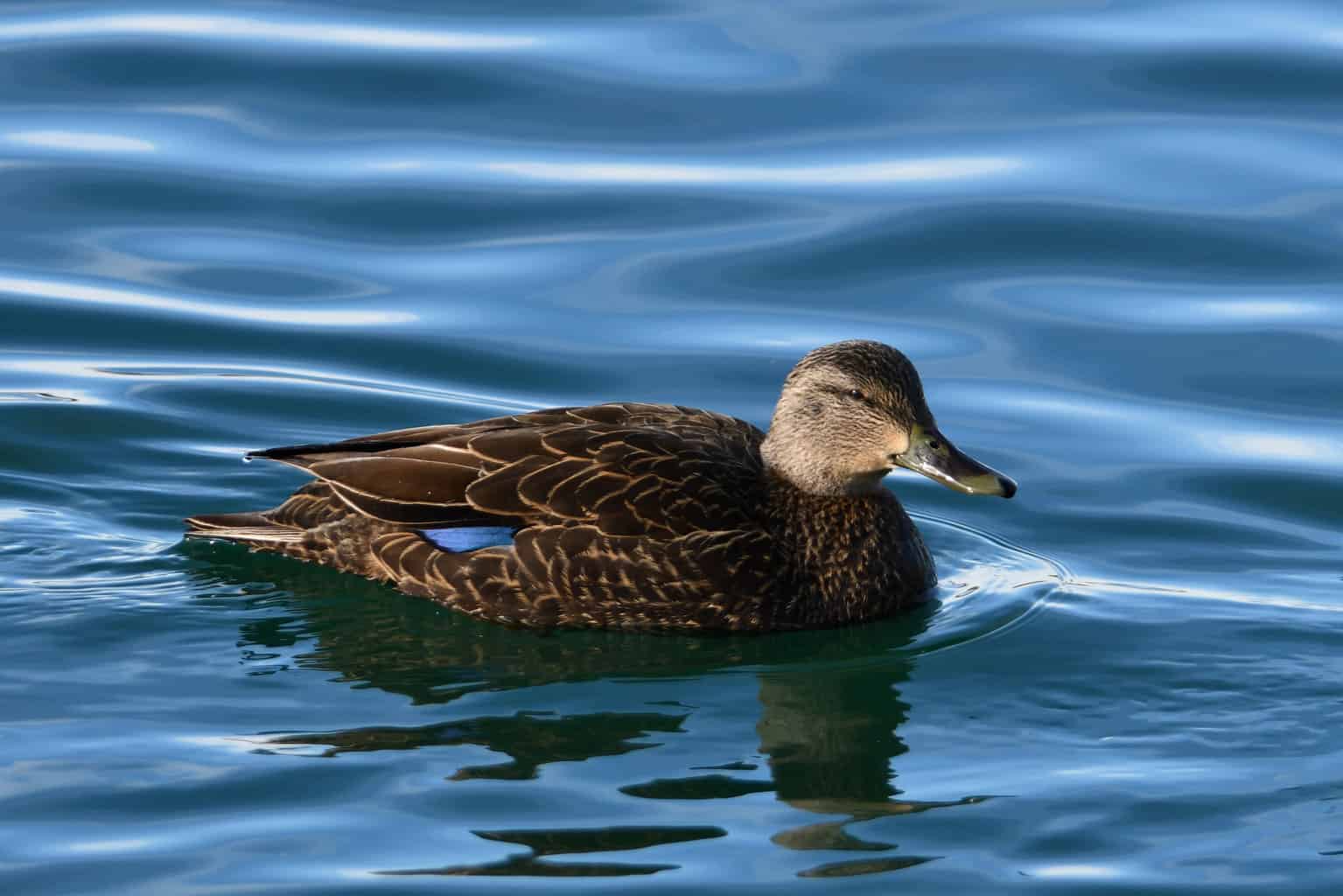
- Anas rubripes
- Length: 21.3-23.2 inches
- Weight: 25.4-57.9 ounces
- Wingspan: 34.6-37.4 inches
American Black Duck males are dark brown with a pattern somewhat reminiscent of the female Mallard. He has a yellow bill and a violent blue speculum that is barely visible while standing, sitting, or swimming.
The female looks almost identical. In fact, the American Black Duck is one of the ducks with the least differentiation between sexes while still being sexually dimorphic. She is slightly lighter brown and has a greenish bill instead of yellow.
American Black Ducks are also exclusive to the eastern half of Noth America. They breed in far northeastern Canada and make their way south and a bit west for the winter.
Their winter territory includes eastern Texas. They prefer agricultural marshes and fields, as well as estuaries and rivers. They are frequently found in conservation areas because they have learned where to avoid hunters.
American Wigeon (Dabbling Duck)

- Scientific Name: Mareca americana
- Length: Up to 14 inches
- Weight: About 2.25 pounds
- Wingspan: 34 inches
The American Wigeon male has a thick white crown and an iridescent green band stretching from his eyes to the back of his head. His bill is light blueish-gray and tipped in black. He has black tips on his wings and a black tail. The rest of his body is mostly brown.
The female is light brown with a gray, stippled head. She has dark eyes and a bill that looks like that of a male. Both sexes are small, compact ducks.
American Wigeons breed in western Canada and Alaska and winter along the Pacific Coast, Atlantic Coast, Gulf Coast, Texas and Mexico, much of the American West, parts of Central America, and the northern rim of South America.
That’s a huge winter range!
You will only see American Wigeons in Texas during the winter, then. They live in areas where there is plenty of aquatic plant life. That includes marshes, bays, agricultural areas, estuaries, inland lakes, and rivers.
Black-Bellied Whistling Duck (Tree Duck)
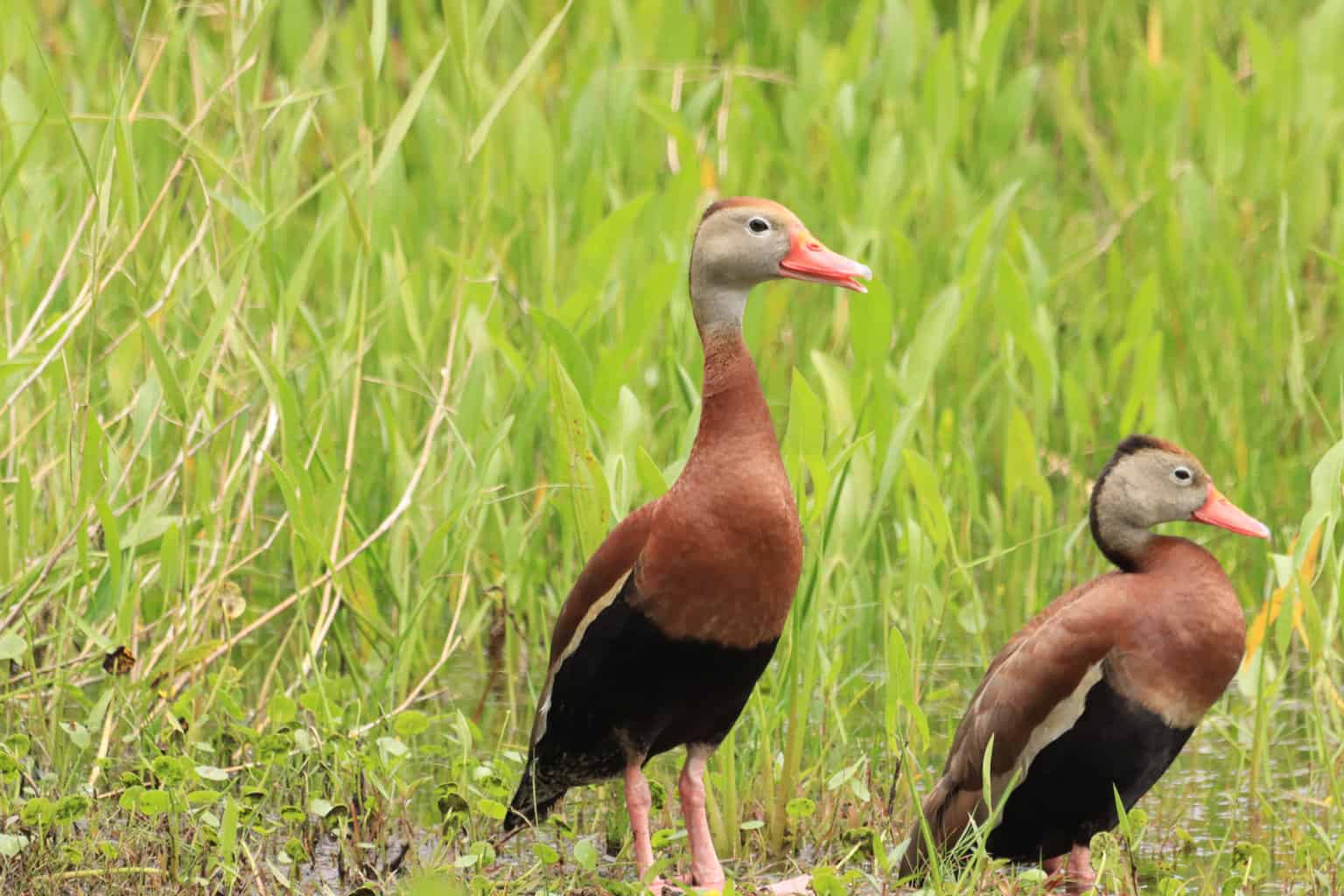
- Dendrocygna autumnalis
- Length: 19 – 22 in (47 – 56 cm)
- Weight: 652 – 1020 g (1.437 – 2.249 lb)
- Wingspan: 30 – 37 in (76 – 94 cm)
Black-Bellied Whistling Ducks are an example of a rare, sexually monomorphic kind of duck. Both males and females have a dark brown breast, gray heads, small dark brown crests, and gray faces. Their bills are pink, and they are dark black underneath (hence their name).
These are noisy ducks who are year-round residents of the southern border of Texas.
Although they nest in cavities like many other ducks, their habit of perching in trees makes them stand out from most other kinds of ducks.
You will find them in small ponds, lakes, and bodies of water, especially in parks and on golf courses.
Black Scoter (Diving Duck)
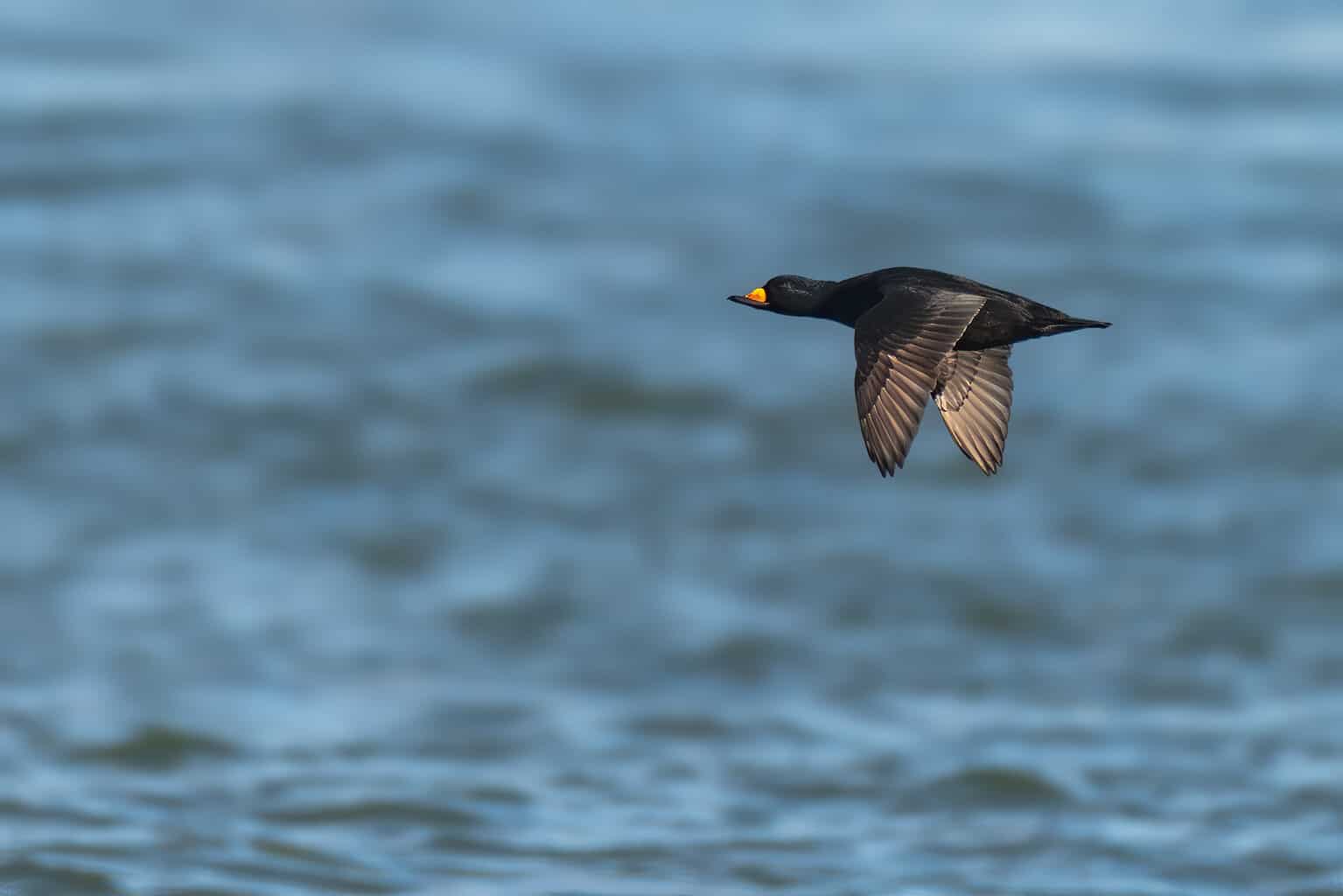
- Melanitta Americana
- Length: 127 – 21 in (43 – 53 cm)
- Weight: 387.4 oz (1088 g)
- Wingspan: 30 – 35 in (76 – 89 cm)
The male Black Scoter’s most interesting feature is his bill: he has a thick black bill with a bright orange bulbous bulge at the base. Otherwise, he is completely black, including his eyes and legs.
The female bill is thick, but there is no bulge at its base. She has light brown and dark brown mottling over most of her body. The top of her head is dark brown, and her cheek is gray.
Black Scoters are winter residents of Texas’s Gulf Coast.
Their diet consists of many saltwater creatures, including mollusks, shrimp, and shellfish. When they are in freshwater, their diet includes fish larvae, fish eggs, and aquatic plants.
Blue-Winged Teal Duck (Dabbling Duck)
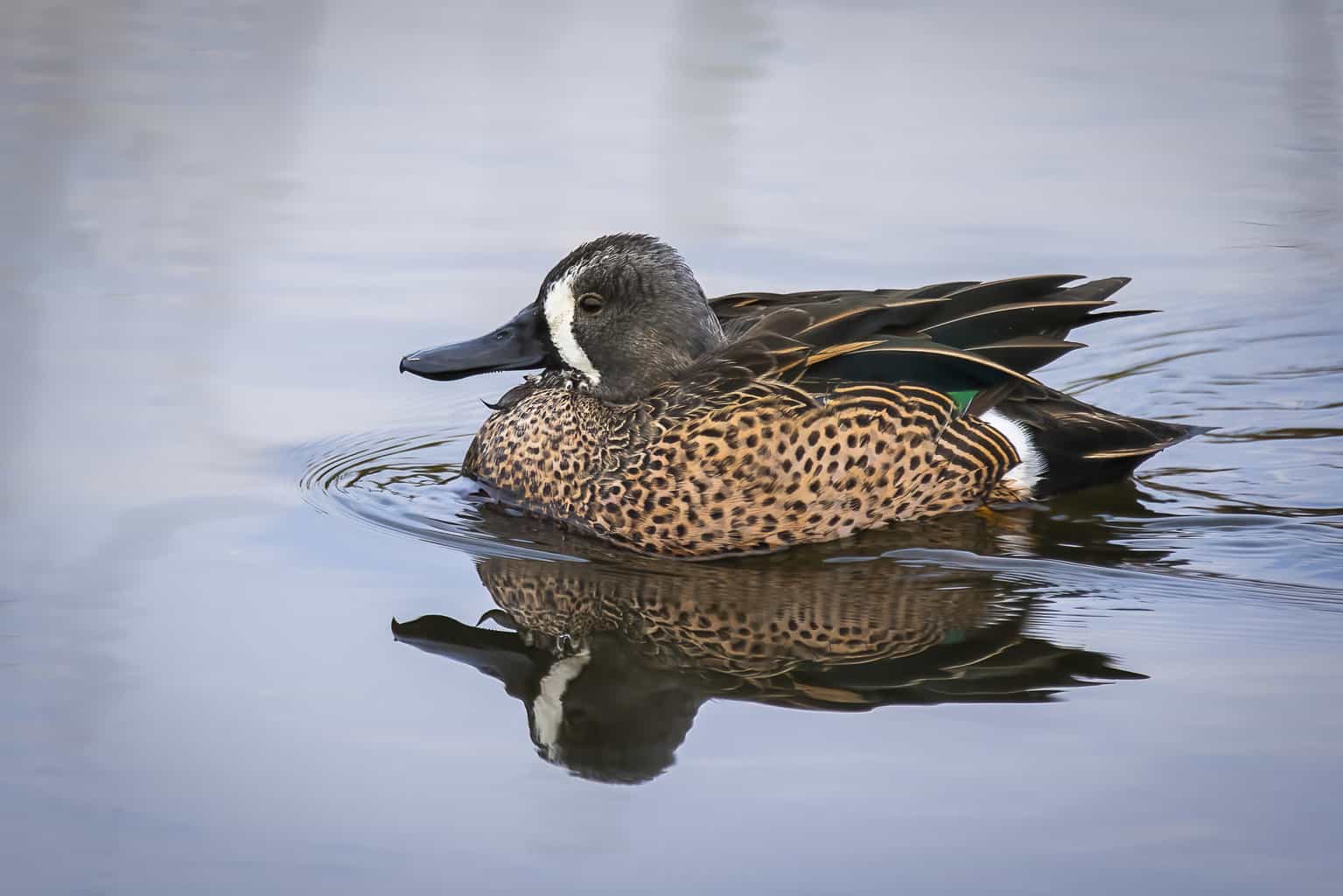
- Spatula discors
- Length: 15 – 17 in (38 – 43 cm)
- Weight: 19.18 oz (544 g)
- Wingspan: 23 -31 in (58 – 79 cm)
Blue-Winged Teal Ducks live year-round in East Texas, winter residents of South Texas, and breeding residents of North Texas.
Male Blue-Winged Ducks have a blue-gray head, a brown, mottled body, and a black back. They have a large white crescent right in front of their eyes, a blue shoulder patch, and a gorgeous green speculum.
Females are mottled brown all over their bodies, and they lack the male’s distinctive facial crescent shape.
Blue-Winged Teal Ducks have incredibly high mortality rates, which may be the result of their long migration. They may be at least partially responsible for the spread of avian influenza to commercial poultry farms, which are plentiful in Texas.
Bufflehead (Diving Duck)
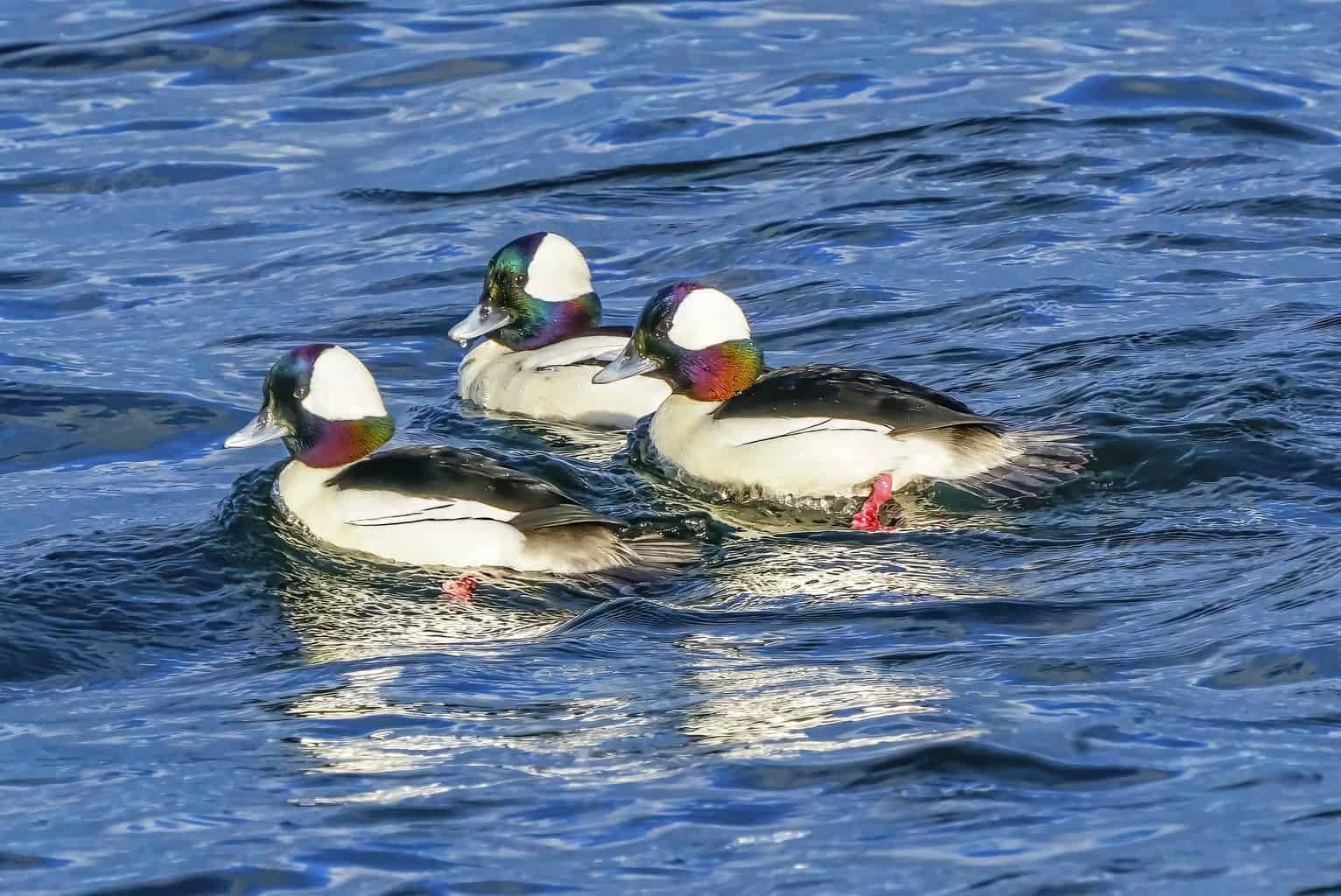
- Bucephala albeola
- Length: 13 – 16 in (33 – 41 cm)
- Weight: 21.16 oz (600 g)
Buffleheads have big round heads that almost look fluffy compared to the smooth, streamlined head of many other ducks.
The male’s head is iridescent purple and green with a big white block from his eyes to the back of his head. The female’s head is dark brown, and she has a white cheek patch on her face.
Buffleheads are winter residents throughout Texas. They live on the Gulf Coast and near inland ponds.
Texas is actually a record-holder when it comes to these ducks: more Buffleheads have been counted in Texas than in any other state in their winter territory. One year, there were 4,300 Buffleheads counted in the state!
Even though Buffleheads are cavity dwellers, they are also really like nest boxes. If you live in an area where Buffleheads are spotted in winter with some frequency, consider building a nest box near a stream, pond, lake, swamp, or marsh.
Canvasback (Diving Duck)
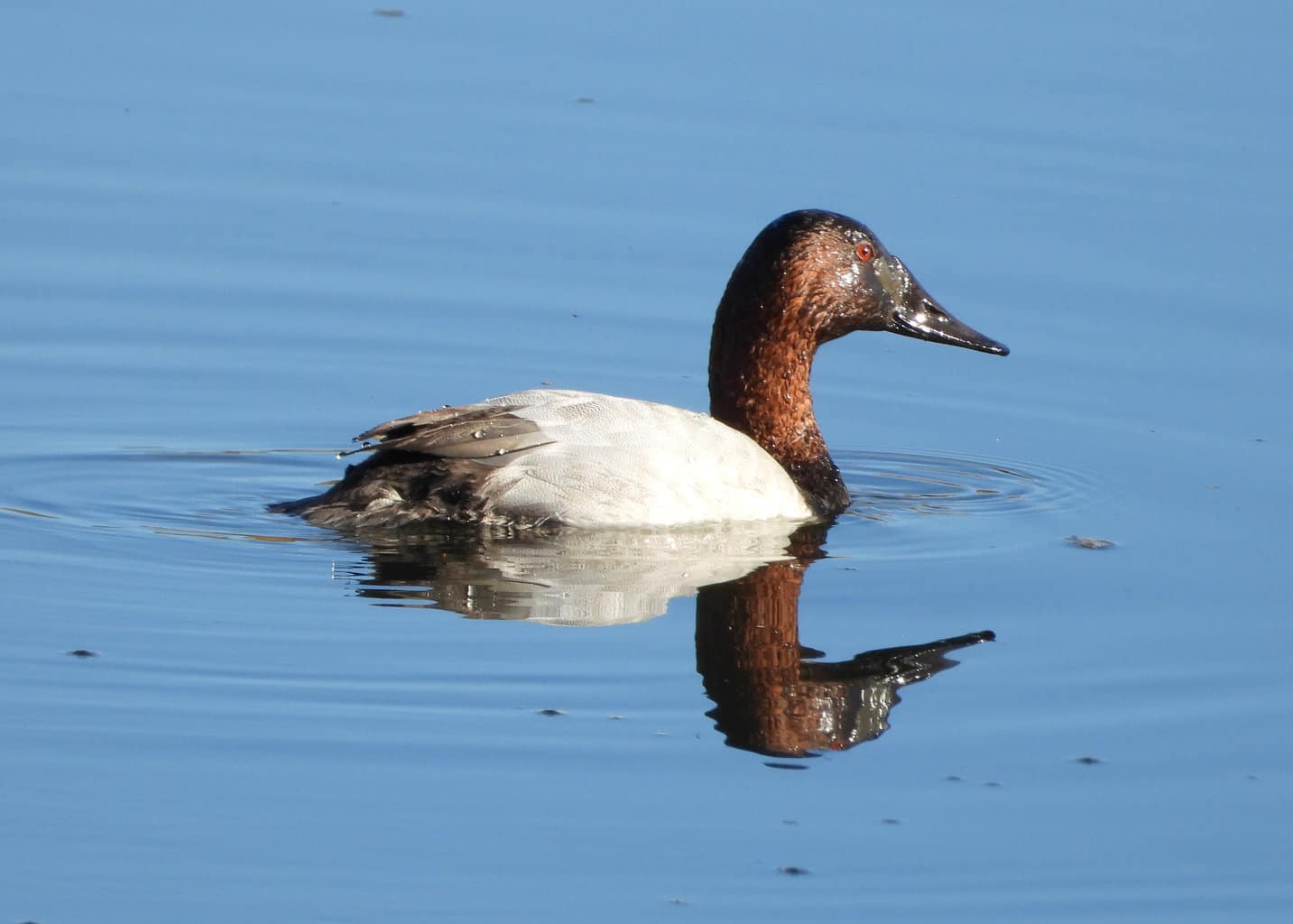
- Aythya valisineria
- Length: 19 – 24 in (48 – 61 cm)
- Weight: 58.48 oz (1657 g)
- Wingspan: 28 – 36 in (71 – 91 cm)
Canvasbacks are the largest diving duck in North America, which makes them one of the biggest ducks on the entire continent.
The male Canvasback has a pattern with significant contrast all over his body. He has a dark, sloping, reddish-brown head and a thick black bill. He has a black breast, a grayish-white back, and black tail feathers. His eyes are red.
Females have similar patterning, but their coloring is much less dramatic. She has black eyes. In flight, male and female Canvasbacks are entirely white on their undersides.
Canvasbacks are found throughout Texas in the winter. In a somewhat quirky piece of behavior, many males and females tend to go to completely different areas in the winter.
Researchers are not entirely sure why this happens. They suspect it has to do with the males’ hardiness and ability to withstand worse weather or the fact that females don’t want to compete with males for safe nesting areas and food.
They will find a mate when it is time to migrate in the spring.
Cinnamon Teal Duck (Dabbling Duck)
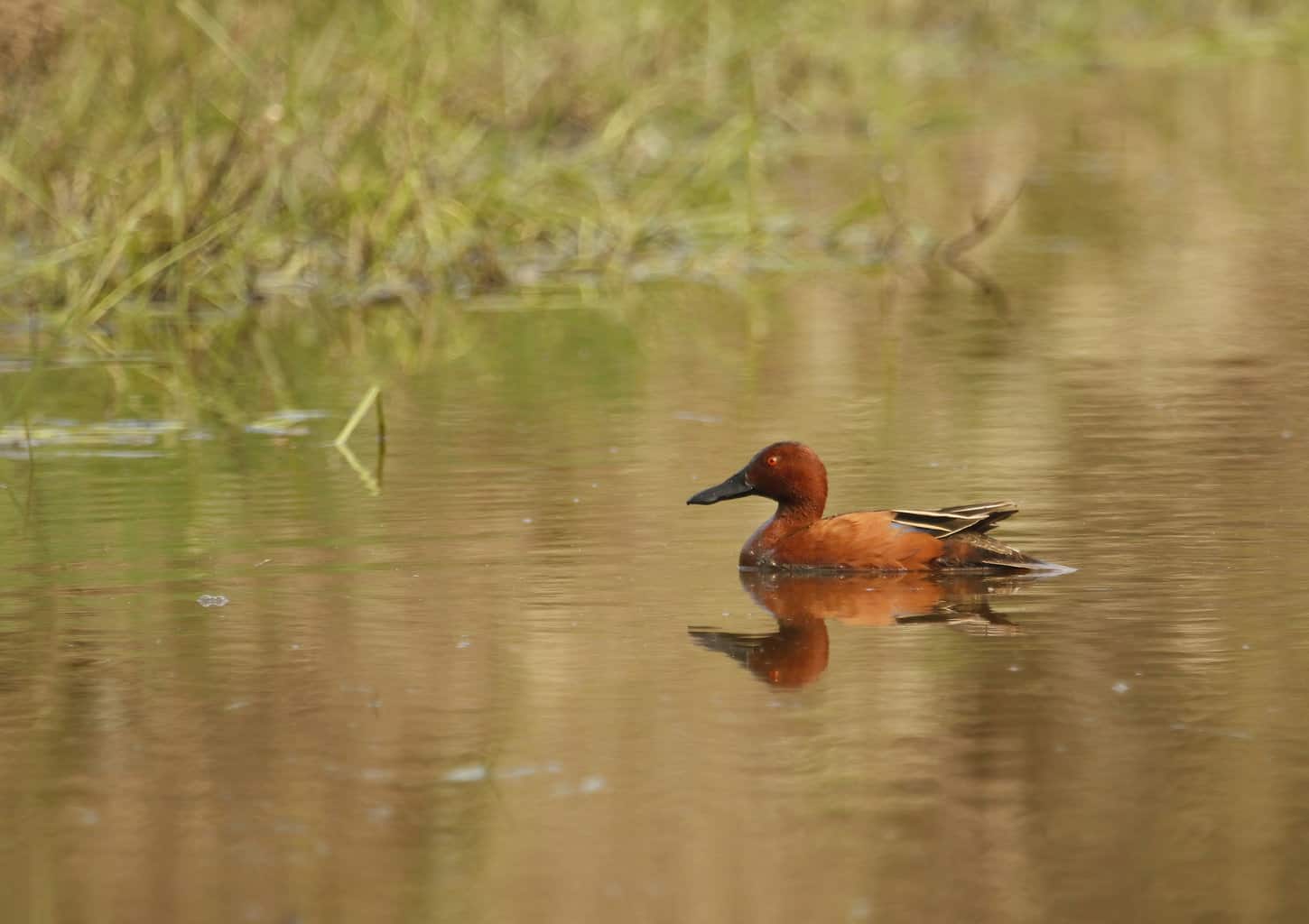
- Scientific Name: Spatula cyanoptera
- Length: 11 inches
- Weight: 12.6-18.2 ounces
- Wingspan: 25 inches
Male Cinnamon Teal Ducks are especially colorful in the breeding season. Their head, neck, breast, and shoulders are all dark, rusty brown, whereas their primary feathers are brown and black. They have green secondary feathers.
After the breeding season, male Cinnamon Teal Ducks lose a lot of their coloring and look more like females: coarsely mottled in light and dark brown. Regardless of season or sex, adult Cinnamon Teal Ducks also have a sky-blue shoulder patch.
Because Texas is so huge, some Texans could see Cinnamon Teal Ducks year-round, while others only see them in the winter or during their migration.
In the southwestern corner of Texas, Cinnamon Teal Ducks are year-round residents. Along the western edge of the Texas Panhandle, they are summer breeders. In most of the Panhandle and East Texas, they are strictly migratory visitors. Finally, some Cinnamon Teal Ducks will settle into southeastern Texas for the winter.
Female Cinnamon Teal Ducks are not cavity-dwellers. Instead, they build their nests in the aquatic and marshy grasses. They actually conceal their nests under dead vegetation, creating tunnels under the grass to gain access to the nest, water, and other spaces.
This is part of why Cinnamon Teal Ducks can be difficult to spot! They are so good at hiding.
Common Goldeneye (Diving Duck)
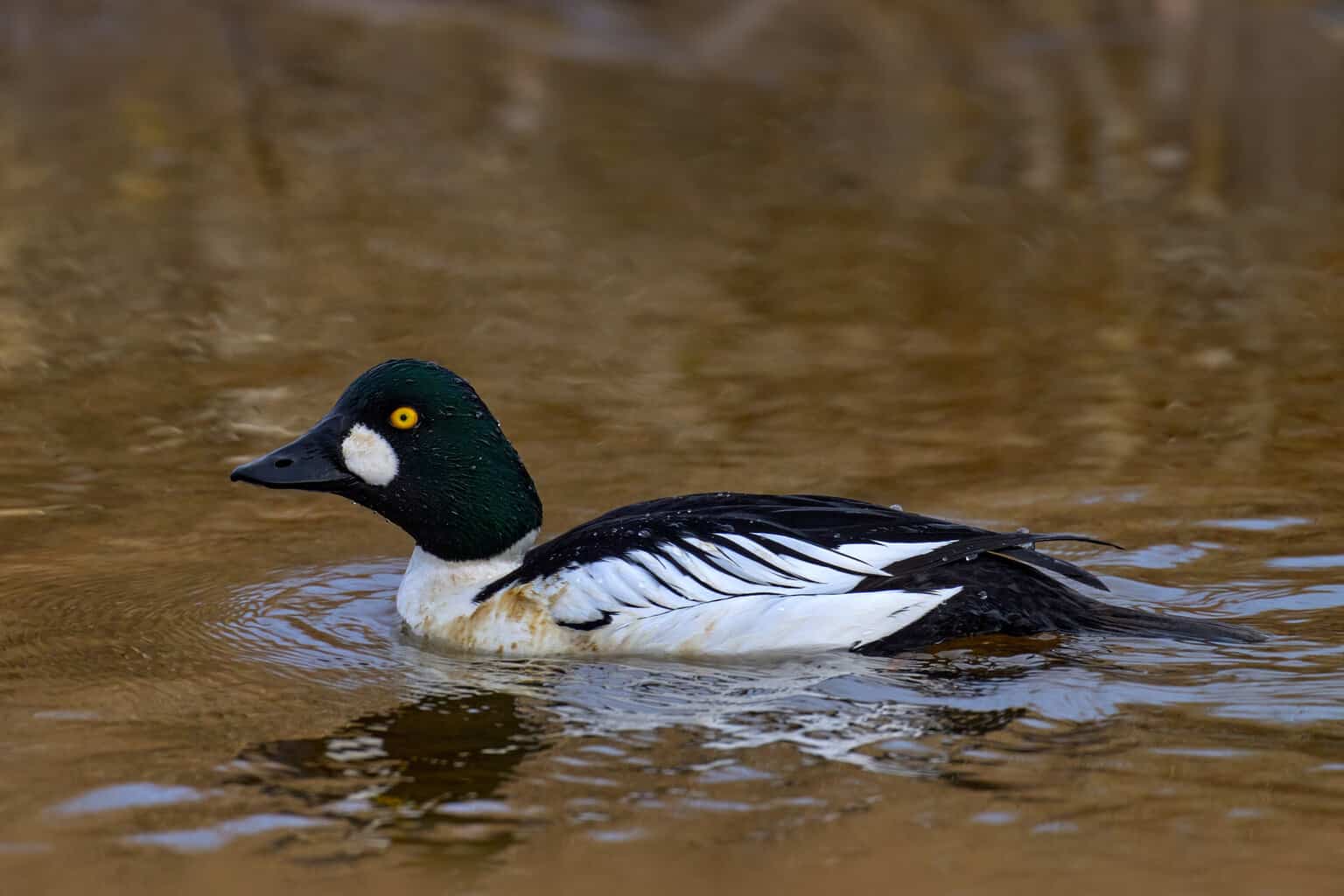
- Bucephala clangula
- Length: 16-20 inches
- Weight: Approximately 1.8 pounds
- Wingspan: 30.3-32.7 inches
Male Common Goldeneyes are mostly black and white. He has an iridescent green head and some white on his wings. He can be differentiated from the Barrow’s Goldeneye (who does not live in Texas) because he has a longer bill.
Females are mostly brown. She has a yellow-tipped bill. Both sexes have bright, golden-yellow eyes.
These ducks are winter residents of northern Texas. They do not live in South Texas except for a small strip of territory along the Gulf Coast.
Common Goldeneyes are aggressive toward one another. This includes females.
Sometimes, when the females fight, the ducklings will become separated from their original brood and end up finding a new Goldeneye nest to join. The female doesn’t seem to notice, and this combination of ducklings from multiple broods is called a crèche.
Common Merganser (Diving Duck)
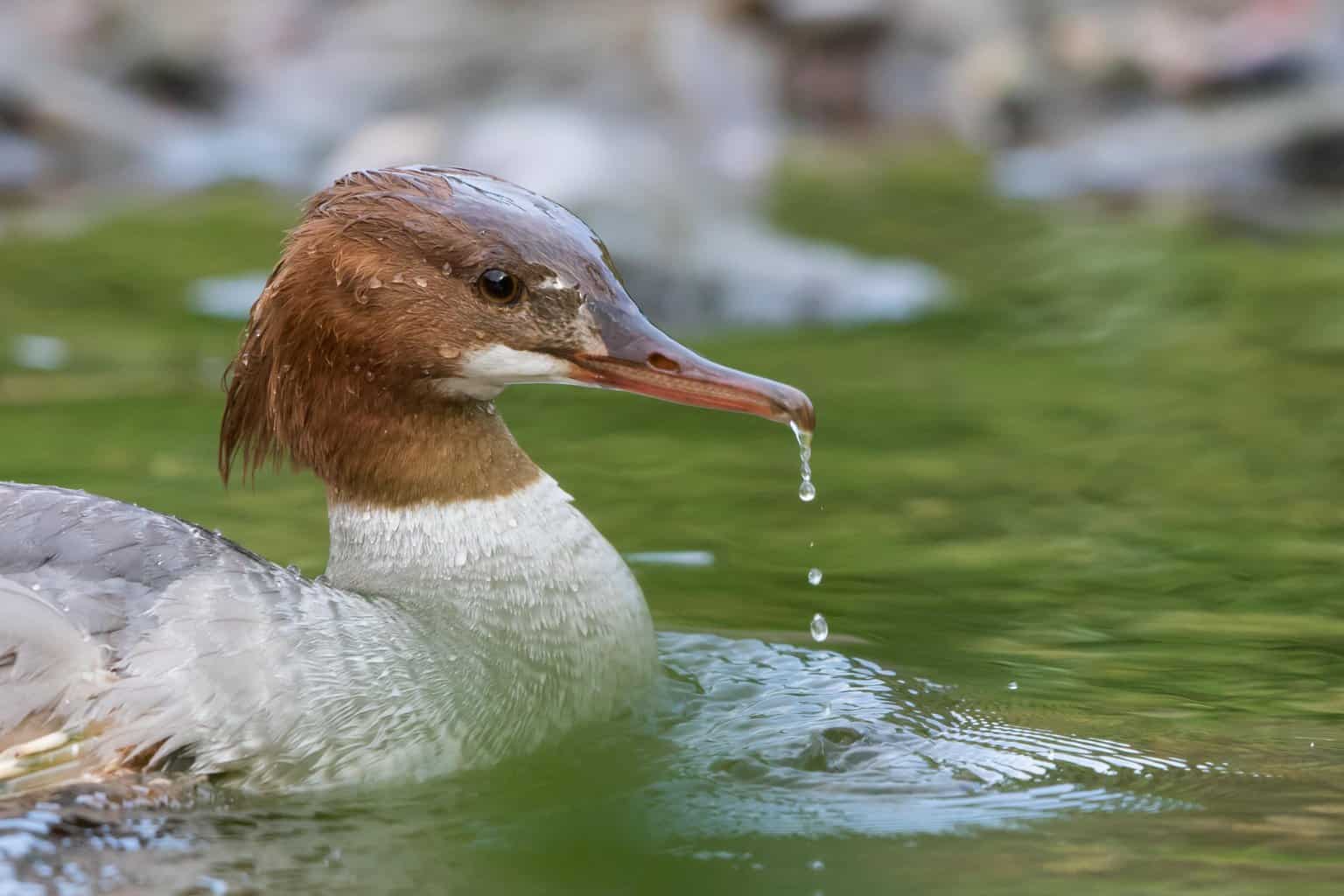
- Mergus merganser
- Length: 22 – 27 in (56 – 69 cm)
- Weight: 60.8 oz (1723 g)
- Wingspan: 31 – 37 in (79 – 94 cm)
Often, males are more unique in their appearance than females, making males easier to identify. Common Mergansers are special because both males and females are immediately identifiable!
Female Common Mergansers have a cinnamon-red head and neck with a pale body. The female’s crest is long and shaggy. She is white-breasted with a gray belly and back.
The male’s head is iridescent green. He has a bright red bill, black eyes, a white underbelly, and a black back. He lacks the distinctive shaggy crest of the female.
Mergansers have serrated bills so that they can rip into the flesh of fish. They also eat mollusks, worms, aquatic insects, frogs, small mammals, crustaceans, and aquatic plants.
They are only seen in western Texas, and only in the winter.
Fulvous Whistling Duck (Tree Duck)
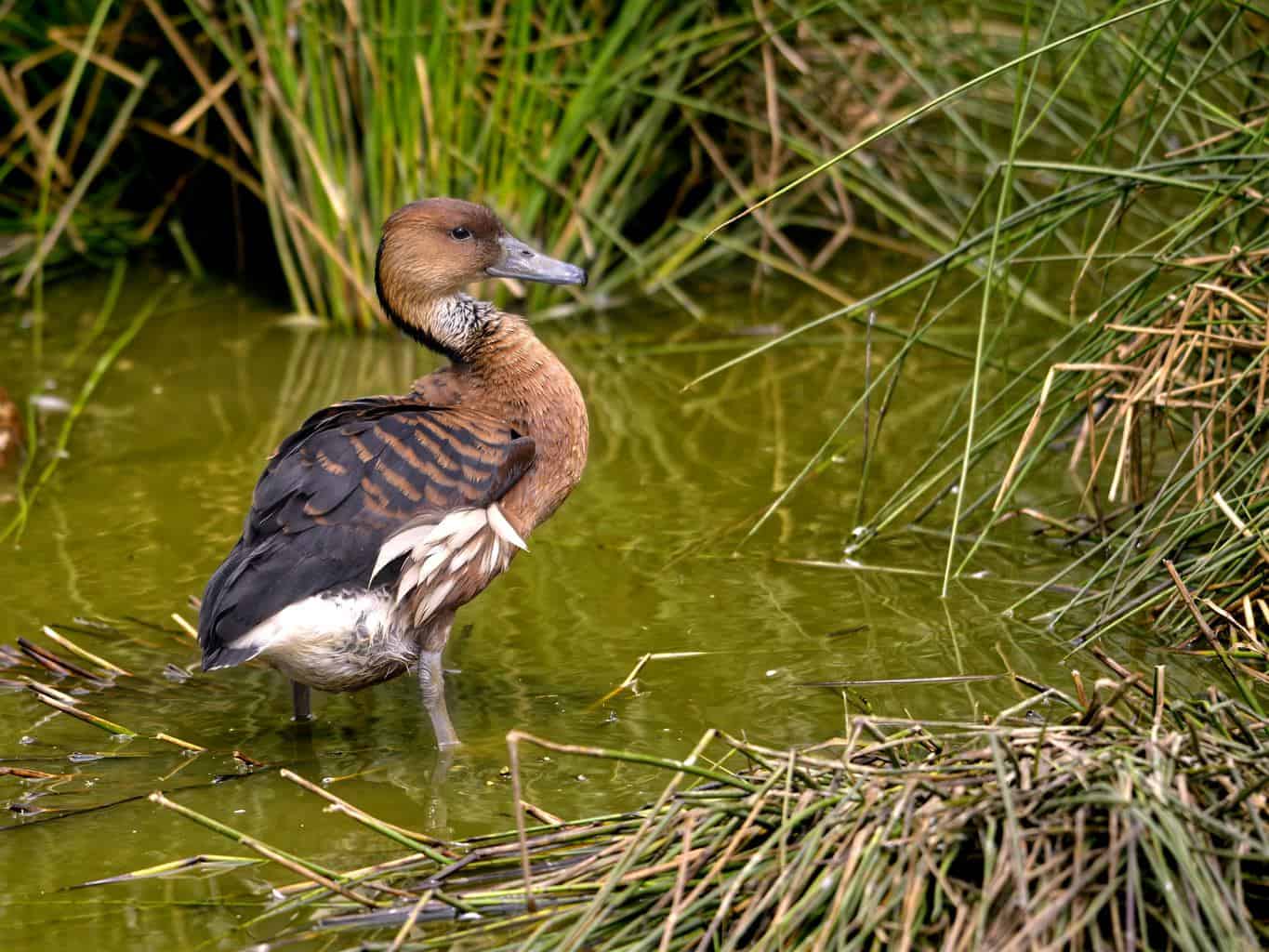
- Dendrocygna bicolor
- Lenth: 18 – 21 in (45 – 53 cm)
- Weight: 25 – 37 oz (1.5 – 2.3 lb)
- Wingspan: 33 – 40 in (83 – 101 cm)
Like other whistling ducks, Fulvous Whistling Ducks are sexually monomorphic, and there is no discernable difference in appearance between males and females.
They are caramel orangeish-red with black-striped backs, long necks, and long legs.
They live in freshwater marshes, preferably near rice fields. They are filter-feeders, which means they strain water through their bills and eat the invertebrates and seeds that they catch (this is also how Nothern Shovelers eat – more on that soon!).
The Fulvous Whistling Duck has a very wide range. It can be found in Africa, South America, Asia, and North America. That said, they are not widespread throughout North America.
Small parts of Texas, California, Louisiana, and Florida are the only states where these ducks consistently breed and live. They are also coastal residents of Mexico, including the Gulf of Mexico and the Gulf of California.
Gadwall (Dabbling Duck)
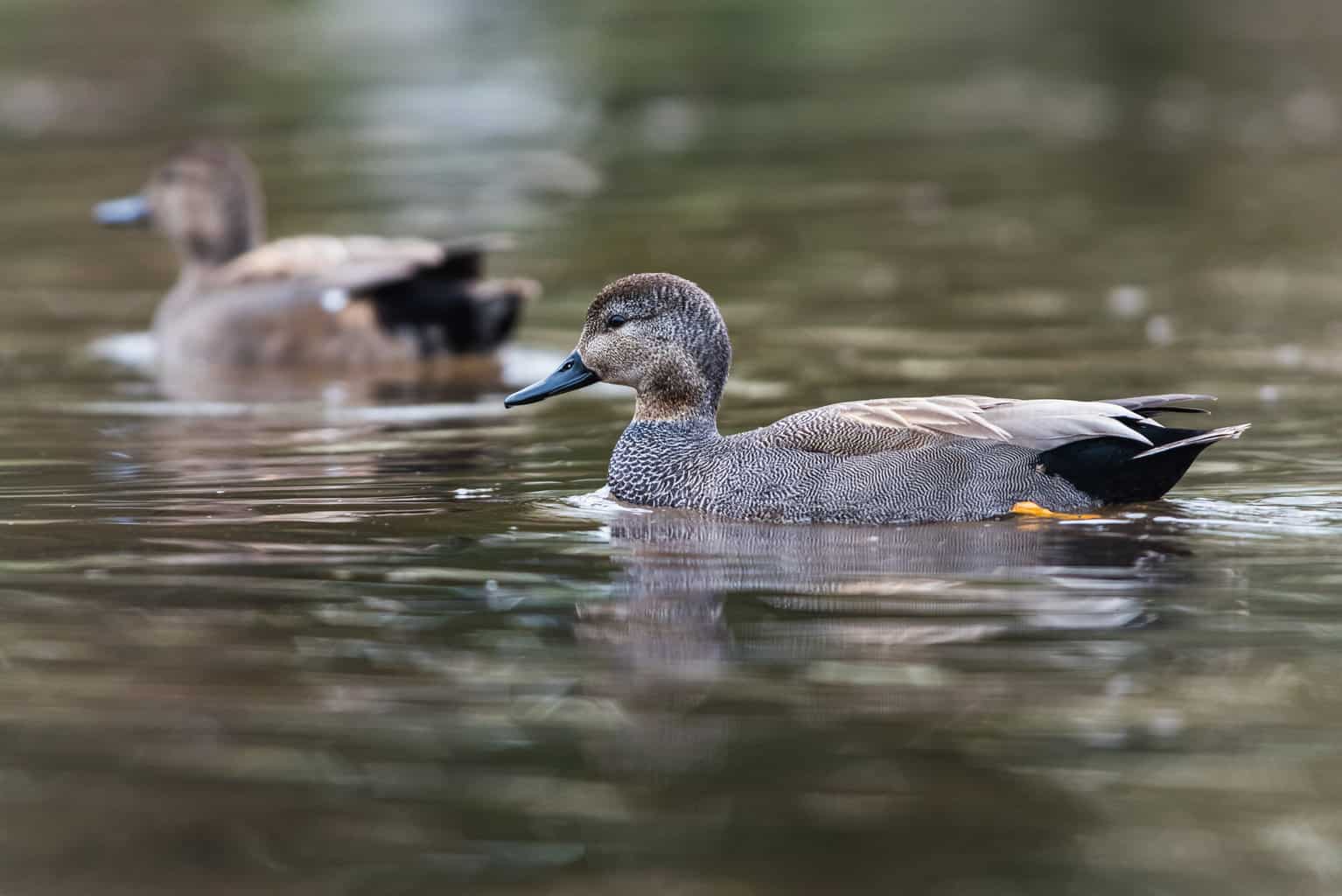
- Mareca strepera
- Length: 19 – 23 in (48 – 58 cm)
- Weight: 35.27 oz (1000 g)
- Wingspan: 31 – 36 in (79 – 91 cm)
Male Gadwall are grayish-brown with delicate designs over most of the body. The male’s chest is covered in an intricate scallop pattern, and he has a black patch of tailfeathers. The female Gadwall has a patchy pattern of dark and light brown.
Although both sexes have white markings on their wings, these are difficult to spot when the duck is sitting, standing, or swimming. In flight, you can see these markings more clearly.
One reason why Gadwall are so plentiful is that they have higher rates of breeding success than any other dabbling duck. There are also one of the most hunted ducks in North America, ranking alongside the Mallard and Green-Winged Teal Duck.
Gadwall are common throughout Texas during the winter. They arrive in August or September and depart at the end of May.
Garganey Duck (Dabbling Duck)

- Spatula querquedula
- Length: 16 in (41 cm)
- Weight: 10.5 – 15.5 oz (300 – 400 g)
- Wingspan: 22.8 – 27.1 in (58 – 69 cm)
Garganey Ducks are small, brown ducks. The male has a white stripe that looks like a long, sloping eyebrow. He is mostly brown and black, but his wings are gray. He has a black bill.
Female Garganey Ducks are lighter in color, and they have smaller, off-white eyebrows. She also has a dark stripe across her eyes. In fact, female Garganeys look very similar to the female Green-Winged Teal Duck.
These ducks are far more common around the world than in North America, but they have been sighted and documented in the gulf water around Corpus Christi.
Greater Scaup (Diving Duck)
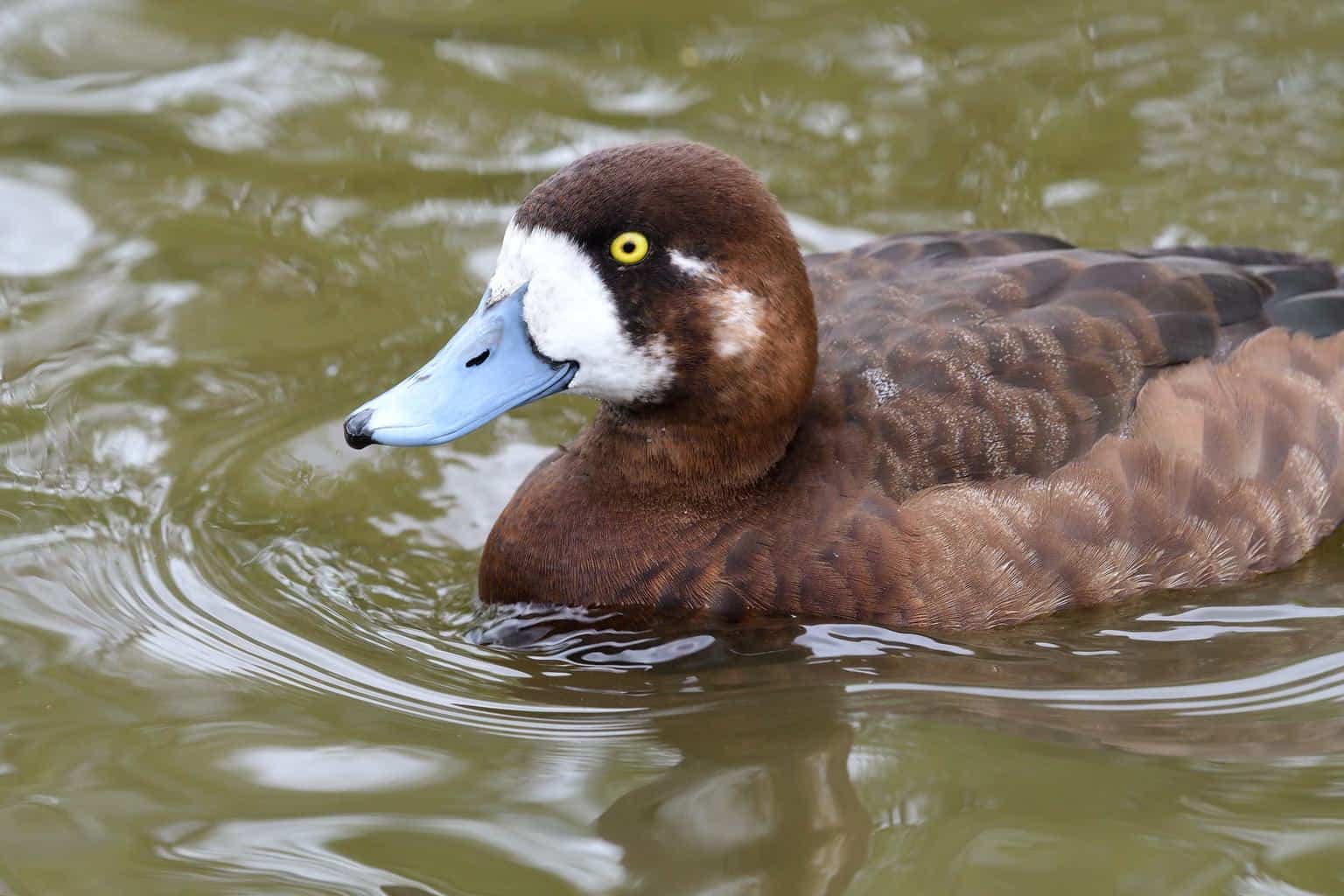
- Aythya marila
- Length: 15-22 inches
- Weight: 1.5-2.9 pounds
- Wingspan: 28-33 inches
Greater Scaup and their close relatives, Lesser Scaup, both live in Texas during the winter.
Breeding male Greater Scaup are mostly white, but they have black and brown bars on their backs. Their head is iridescent green. During the winter, when they are present in Texas, they look like a hybrid version of their breeding appearance and a female.
The female Greater Scaup is light brown with a dark brown head. She has minimal markings, except for a thick pale ring on her face, right near the base of her bill.
Male and female Greater Scaup have thick, slate-blue bills.
Green-Winged Teal Duck (Dabbling Duck)
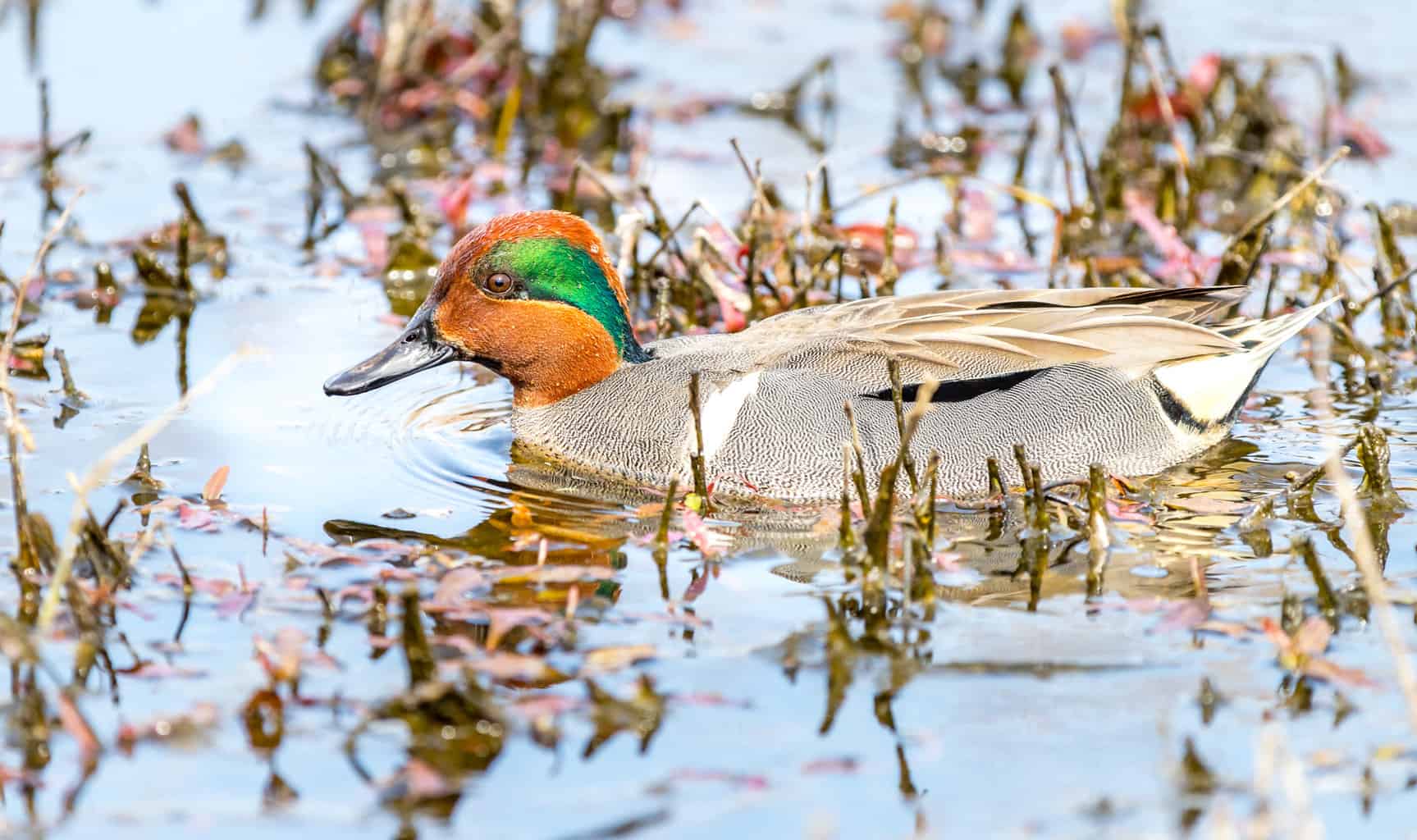
- Anas crecca
- Length: 12.2 – 15.3 in (31 – 39 cm)
- Weight: 4.9 – 17.6 oz (140 – 500 g)
- Wingspan: 20.5 – 23.2 in (52 – 59 cm)
Male Green-Winged Teal Ducks are easy to recognize because of the iridescent green stripe running from the eyes to the back of the head, curving downward toward the neck. The rest of his head is chocolatey-brown, and his body is gray.
The female Green-Winged Teal Duck is light and dark brown, with lots of variation in her feathers. She has a yellow streak on her tail. Both sexes have an iridescent green speculum on the wings, which is how they got their name.
Green-Winged Teal Ducks are winter-only residents of Texas. They breed across most of Canada and then settle into the southern range of the US and Mexico for the winter.
Here’s a fascinating fact about Green-Winged Teal Ducks: they can take off directly from the water, without any sort of running start!
Hooded Merganser (Diving Duck)
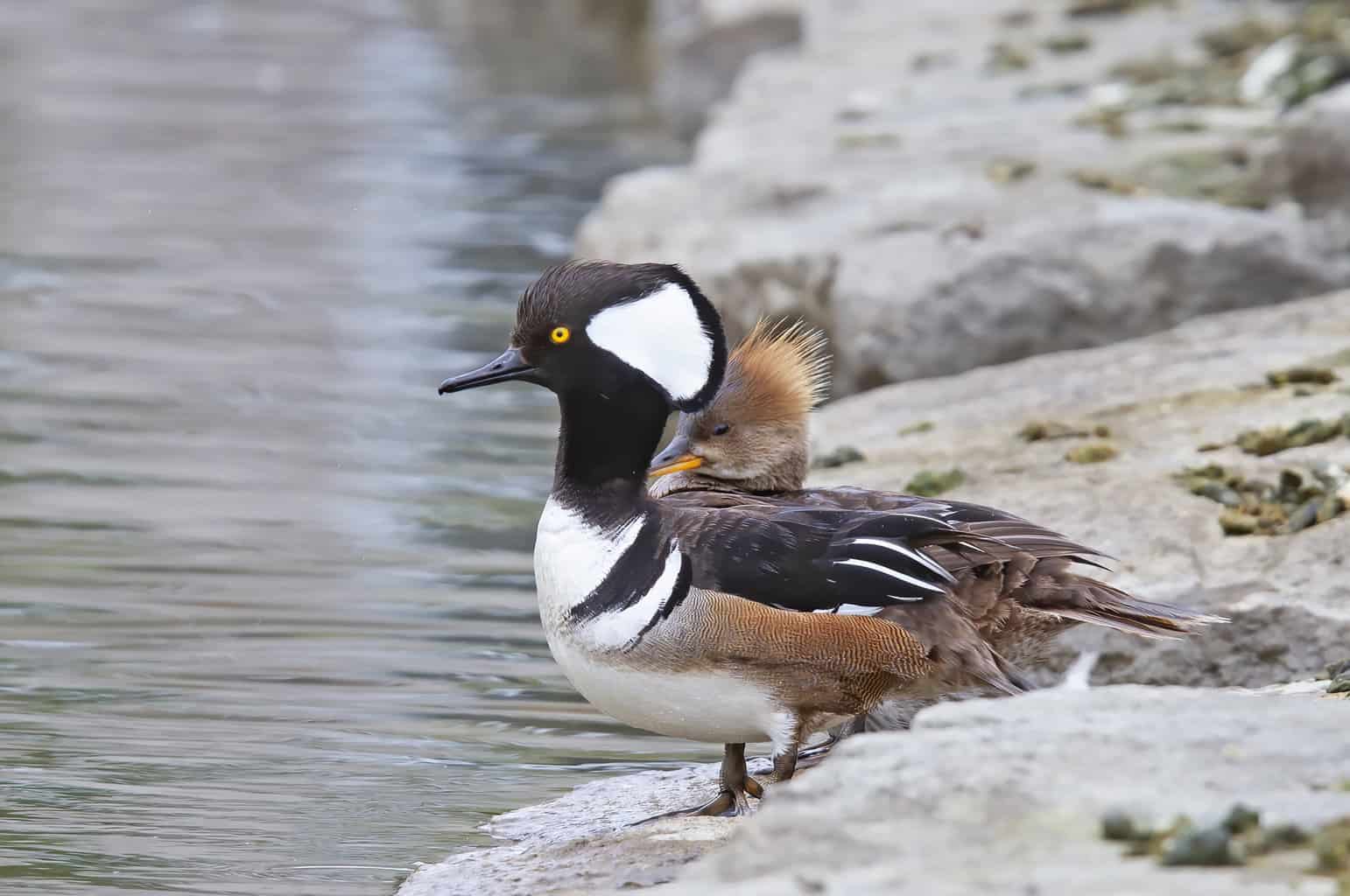
- Lophodytes cucullatus
- Length: 16 – 19 in (41 – 48 cm)
- Weight: 32.09 oz (909 g)
- Wingspan: 24 – 26 in (61 – 66 cm)
The male Hooded Merganser has a black and white, fan-shaped crest. He can also lower the crest so that it is close to his head and almost unnoticeable. The rest of his body is black and white, too, except for his light brown sides.
Female Hooded Mergansers have a shaggy cinnamon-brown crest, similar to the Common Merganser. Otherwise, she has very few markings on her brown body.
Hooded Mergansers live in most of Texas during the winter, but they do not visit Big Bend Country in the western part of the state.
Because of their unique vocalizations that sound like a pickerel frog, Hooded Mergansers have the nickname “frog duck“.
Lesser Scaup (Diving Duck)
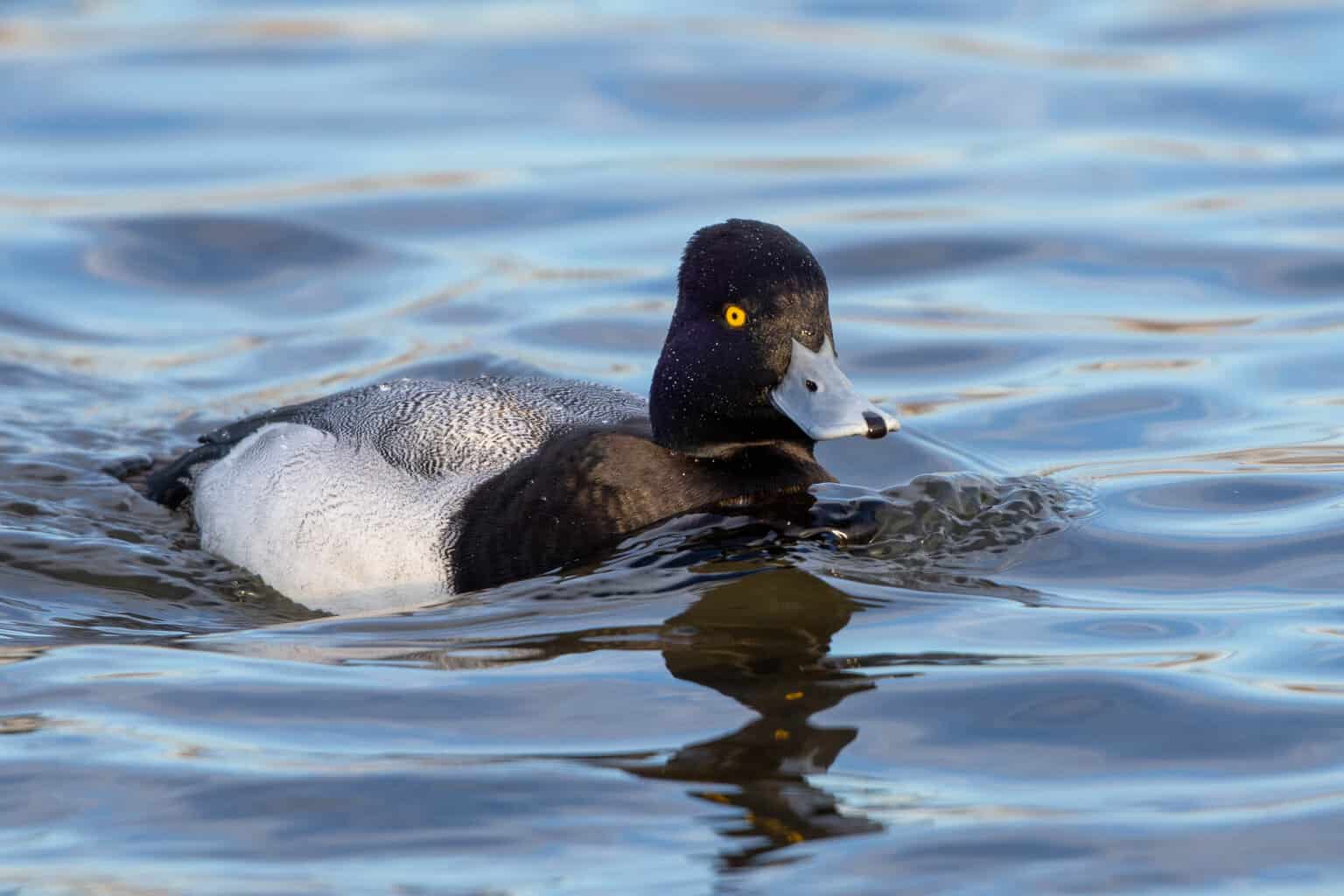
- Aythya affinis
- Length: 15 – 18 in (38 – 49 cm)
- Weight: 40.77 oz (1155 g)
- Wingspan: 24 – 33 in (61 – 84 cm)
Lesser Scaup, like Greater Scaup, are winter residents in most of Texas. They tend to avoid nesting in the very northern edge of the panhandle, though, and are only migratory visitors here.
Males have an iridescent head atop a barred, gray, and white body. From a distance, the male’s head looks almost black.
Female Lesser Scaup are dark brown with a white patch on their face, near the base of their bill. This is similar to the Lesser Scaup’s facial markings.
Male and female Greater Scaup have one thing that Lesser Scaup don’t: a few “stray hairs” on the top of their head.
Lesser Scaup are excellent at the defense mechanisms that help them avoid predators: camouflage and playing dead.
Long-Tailed Duck (Diving Duck)
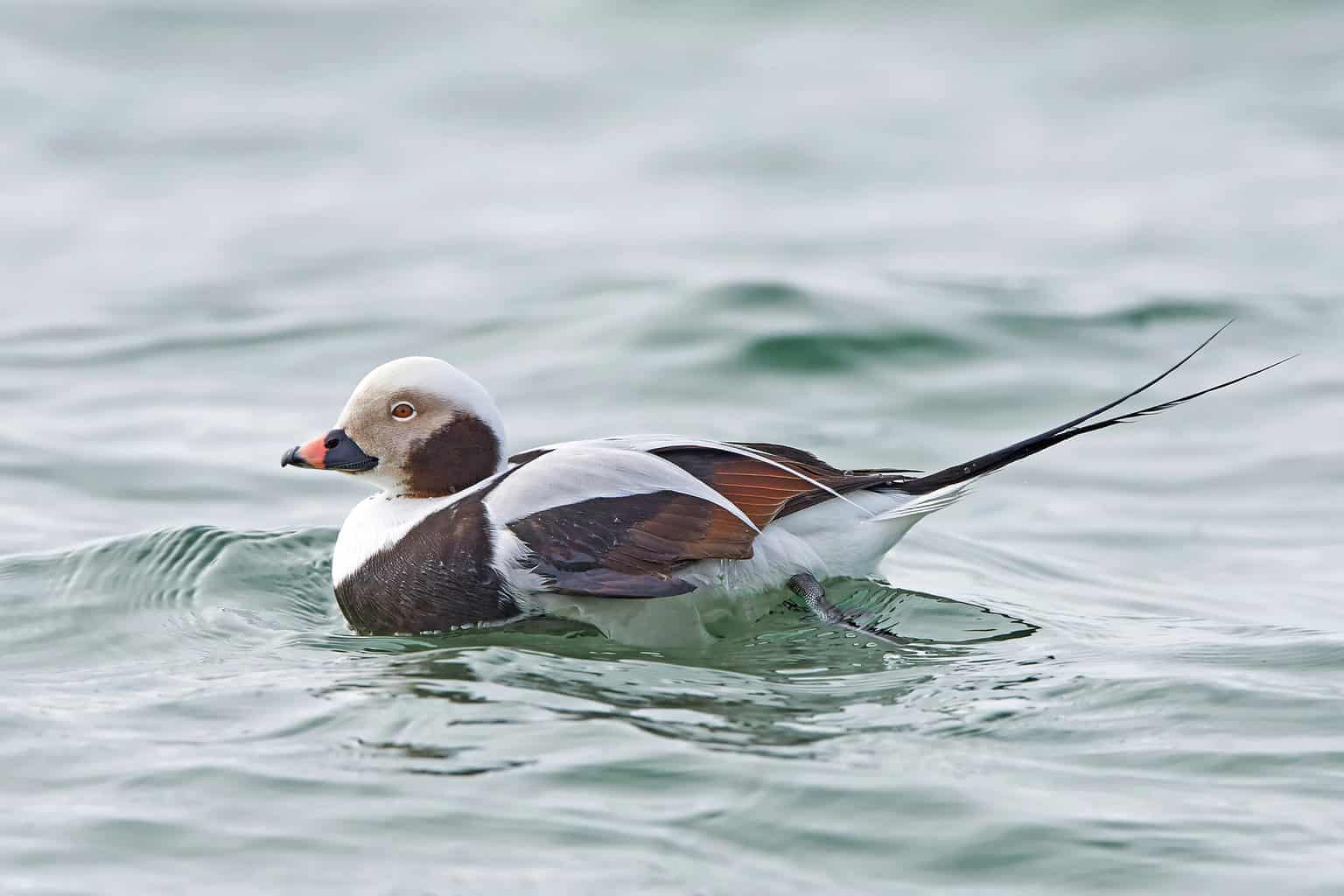
- Clangula hyemalis
- Length: 15 – 22 in (38 – 56 cm)
- Weight: 31.74 oz (900 g)
- Wingspan: 26 – 31 in (66 – 79 cm)
Long-Tailed Ducks have a fascinating and unusual trait: they completely reverse their colors between summer and winter. Plenty of male ducks lose their vibrancy after the breeding season, but Long-Tailed Ducks have a full reversal of their colors – both males and females!
During the winter, male Long-Tailed Ducks are black and white. His white areas are his shoulders, crown, forehead, neck, back, and belly. He has a gray mask across his eyes. Some parts of him are black: cheek patches, breast, tailfeathers, and wings.
When the breeding season arrives, everything that was white turns black, and everything black turns white!
Females in winter have a white head and brown body. By summer, they have a brown head and white body!
They are exceptionally rare in Texas, but they have been sighted in the state. One birder wrote about his desire to spot Long-Tailed Ducks in Texas without any luck just yet.
Mallard (Dabbling Duck)
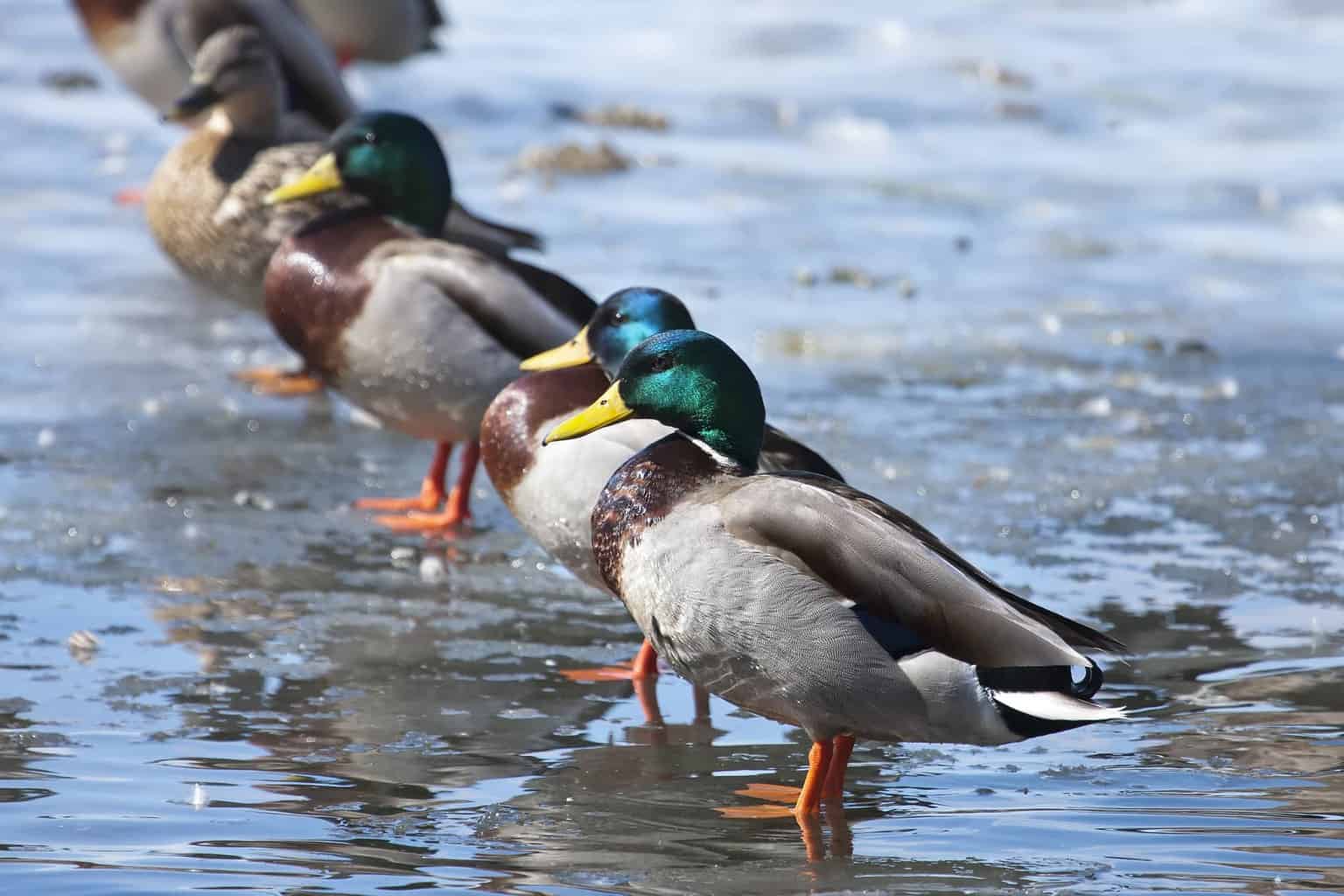
- Anas platyrhynchos
- Length: 19.7 – 25.6 in (50 – 65 cm)
- Weight: 35.3 – 45.9 oz (1000 – 1300 g)
- Wingspan: 32.3 – 37.4 in (82 – 95 cm)
Is there any duck as iconic as the Mallard?
The male Mallard has an iridescent green head, bright yellow bill, white neck ring, gray body, brown breast, and powdery-blue speculum. He is sleek and elegant.
Females are very different from males, but still pretty easy to identify. They have brown and speckled streaks all over their body, and their head is light brown.
Mallards are common in art – especially oil paintings – and home decor, jewelry, collector’s items, and even kids’ Squishmallows.
- Squeeze, cuddle, repeat! Squishmallows are the softest, cutest plush toys around!
- Your new cuddle buddy awaits! Meet Avery the Mallard! Squishmallows have a style and personality all their own, encouraging fun...
- Snuggle up with the squishiest friend in town! These super soft, collectible plush toys make great cuddle companions! The squishy...
Last update on 2024-07-26 / Affiliate links / Images from Amazon Product Advertising API
Mallards are not just the most common duck in North America. They are the most common duck in the whole world! They are widespread all over the globe.
You will find Mallards throughout Texas. They are winter residents in the east and south, and year-round residents in the west and north.
Mandarin Duck (Dabbling Duck)

- Aix galericulata
- Length: 16 – 19 in (41 – 49 cm)
- Weight: 17.7 – 20 oz (444 – 500 g)
- Winsgpan: 25.5 – 29 in (65 – 75 cm)
The Mandarin Duck might be the most stunning duck on the list of interesting Texas ducks. Unfortunately, they are incredibly rare, so seeing one in Texas is unusual. It even made the news when one was documented in a Harlingen park in 2022.
Males are ornately patterned in orange, purple, blue, white, yellow, black, and green. He has what are called “sail fins” on his back, and he has a cute little red bill with a pale tip.
Females are mostly brown, with a dappled chest and a shaggy head. She has a white ring around her eye, and a thin stripe running from her eyes to the back of her head.
The Mandarin Duck’s presence is difficult to predict in Texas because they are such rare migrants.
Masked Duck (Diving Duck)
- Nomonyx dominicus
- Length: 11.8 – 14.1 in (30 – 36 cm)
- Weight: 9.7 – 15.8 oz (275 – 450 g)
- Wingspan: 16.9 in (43 cm)
The male Masked Duck has a black face mask, rusty-brown body, and blue bill with a black tip. The female has two dark stripes on her face, which is otherwise cream-colored. The rest of her body is dark brown, and her bill is black.
Even though Masked Ducks are usually only present in tropical environments, some individuals will find their way to Texas and Florida most years. They are quite small and don’t even weigh a pound!
They are nighttime feeders who sleep during the day, which makes them more difficult to find. They are reclusive ducks whose feeding habits have been difficult to study.
Researchers believe that their diet mostly consists of aquatic plants and seeds, as well as crustaceans and aquatic insects.
Mexican Duck (Dabbling Duck)
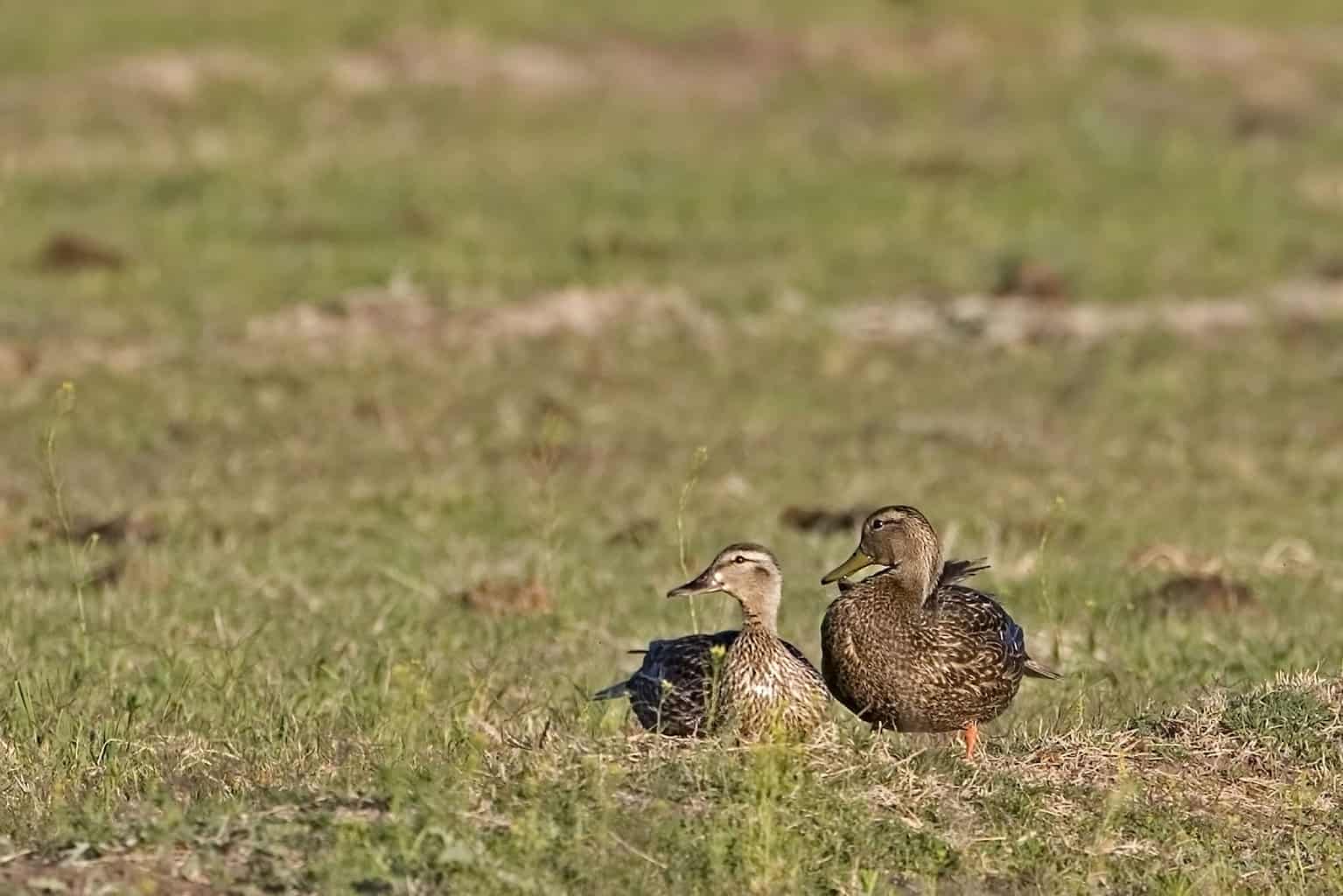
- Anas diazi
- Length: 20 – 22 in (51–56 cm)
- Weight: 25.5 oz (725 g)
- Wingspan: 32.3 – 37.4 in (82 – 95 cm)
Male and female Mexican Ducks look just about the same. Their appearance is very similar to a female Mallard. In fact, the Mexican Duck was once considered to be the same species as the Mallard.
The biggest difference between a male and female Mexican Duck is that the male’s bill is dull yellow, while the female’s bill is mottled in black and orange (much like a Mallard).
In flight, you can easily differentiate between a Mallard and a Mexican Duck because the Mallard has only one white band on its speculum, whereas the Mexican Duck has two white stripes.
That’s not a very big difference, but at least it’s a measurable one!
Mexican Ducks breed with Mallard Ducks, which can add to the confusion in identifying their offspring.
They are winter residents of South Texas and year-round residents of North Texas.
Mottled Duck (Dabbling Duck)
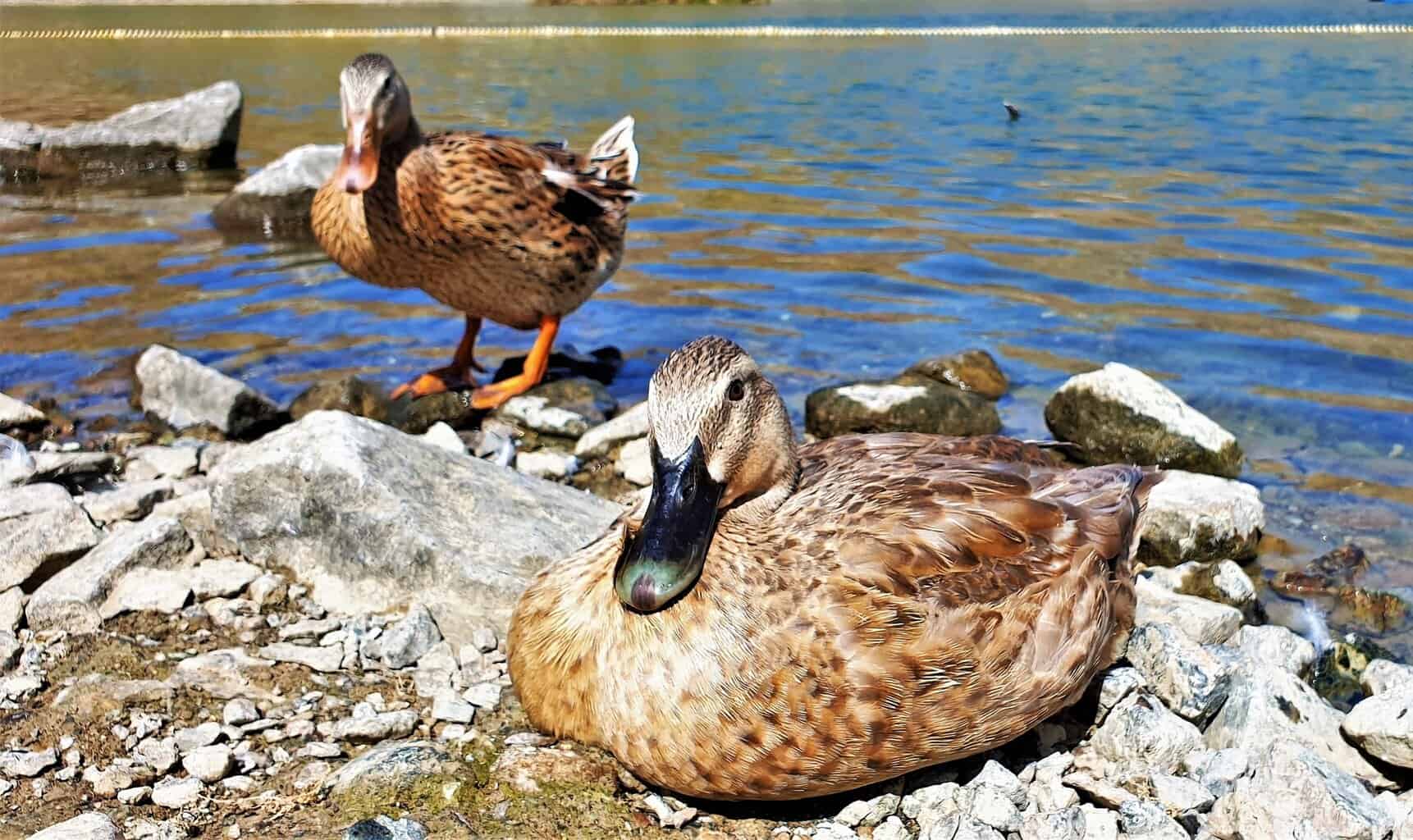
- Anas fulvigula
- Length: 18.5-21 inches
- Weight: 24.7-40.6 ounces
- Wingspan: 31.5-34.3 inches
Like Mexican Ducks, Mottled Ducks are only barely sexually dimorphic. Males and females alike have streaked feathers in light and dark brown, yellow bills, and comparable markings.
Females are slightly muted compared to males, and their bill has a hint of green.
They are almost exclusively found in Florida, Louisiana, and Texas. They are year-round residents of Texas’s Gulf Coast region.
The Audubon Society writes, “Mottled Ducks are almost never seen in large flocks, generally traveling in pairs or small groups. A major threat to their survival is the release of numerous pet Mallards in Florida and elsewhere in the southeast; these feral birds interbreed with Mottled Ducks, diluting the wild population of the latter.”
Muscovy Duck (Dabbling Duck)
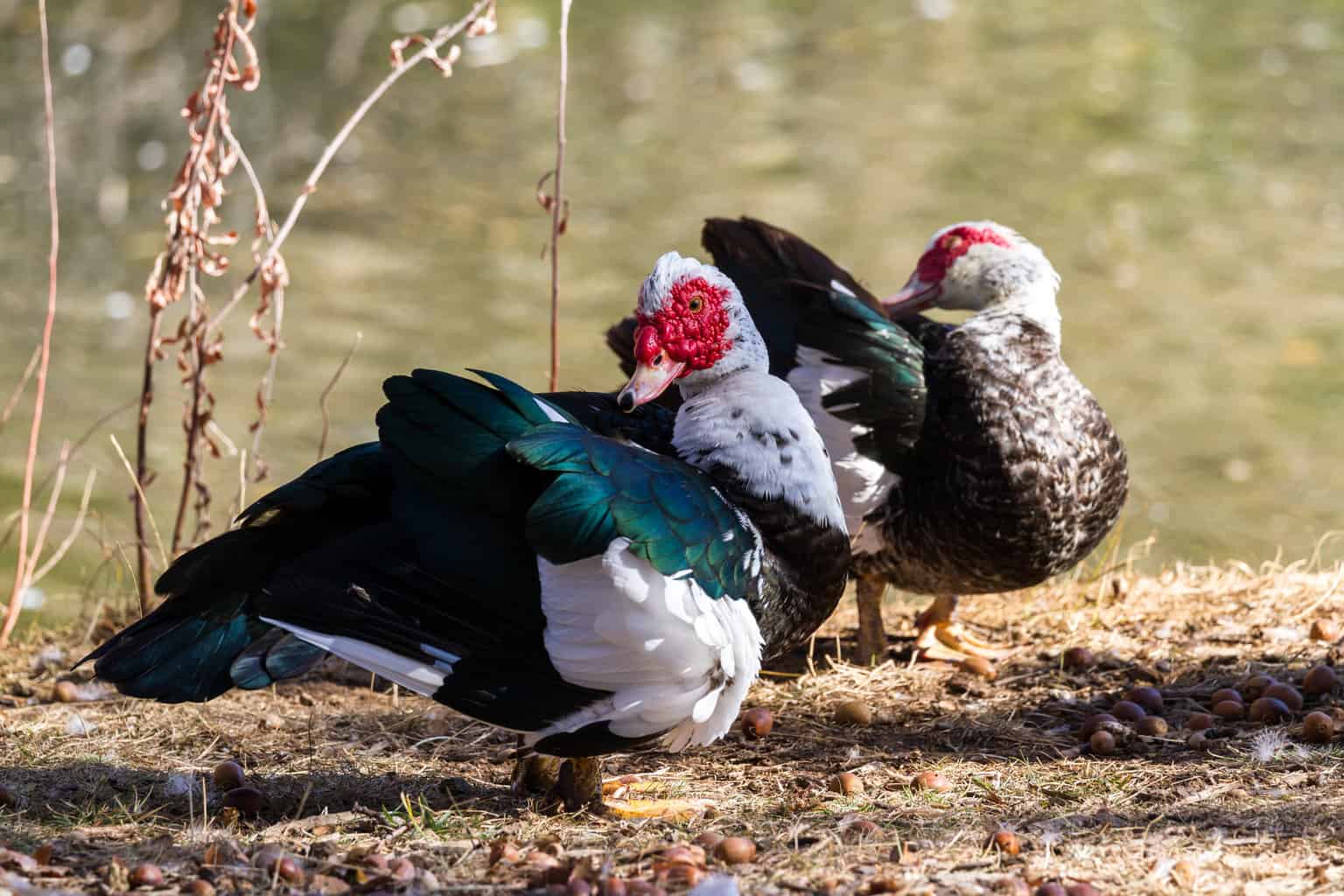
- Cairina moschata
- Length: 26 – 33 in (66 – 84 cm)
- Weight: 2.4 – 9.0 lb (1.1 – 4.1 kg)
- Wingspand: 54 – 60 in (137 – 152 cm)
The male Muscovy Duck is the largest, heaviest duck in North America. He has large white patches on his wings, but otherwise, he is mostly black.
The female is much smaller than the male. She is also mostly black, and she may have some of the same white patches on her body. You can usually identify the female Muscovy Duck by noticing how much smaller she is than the male, and she has a more compact body.
Muscovy Ducks have red facial skin, and they are prone to developing many large, irregular red growths on their faces. They look like warts.
Wild Muscovy Ducks live along the southern edge of Texas, including the Gulf Coast, and stretch further south into Mexico and South America.
Domesticated Muscovy Ducks are found in cities, ponds, and farms throughout North America.
Northern Pintail (Dabbling Duck)
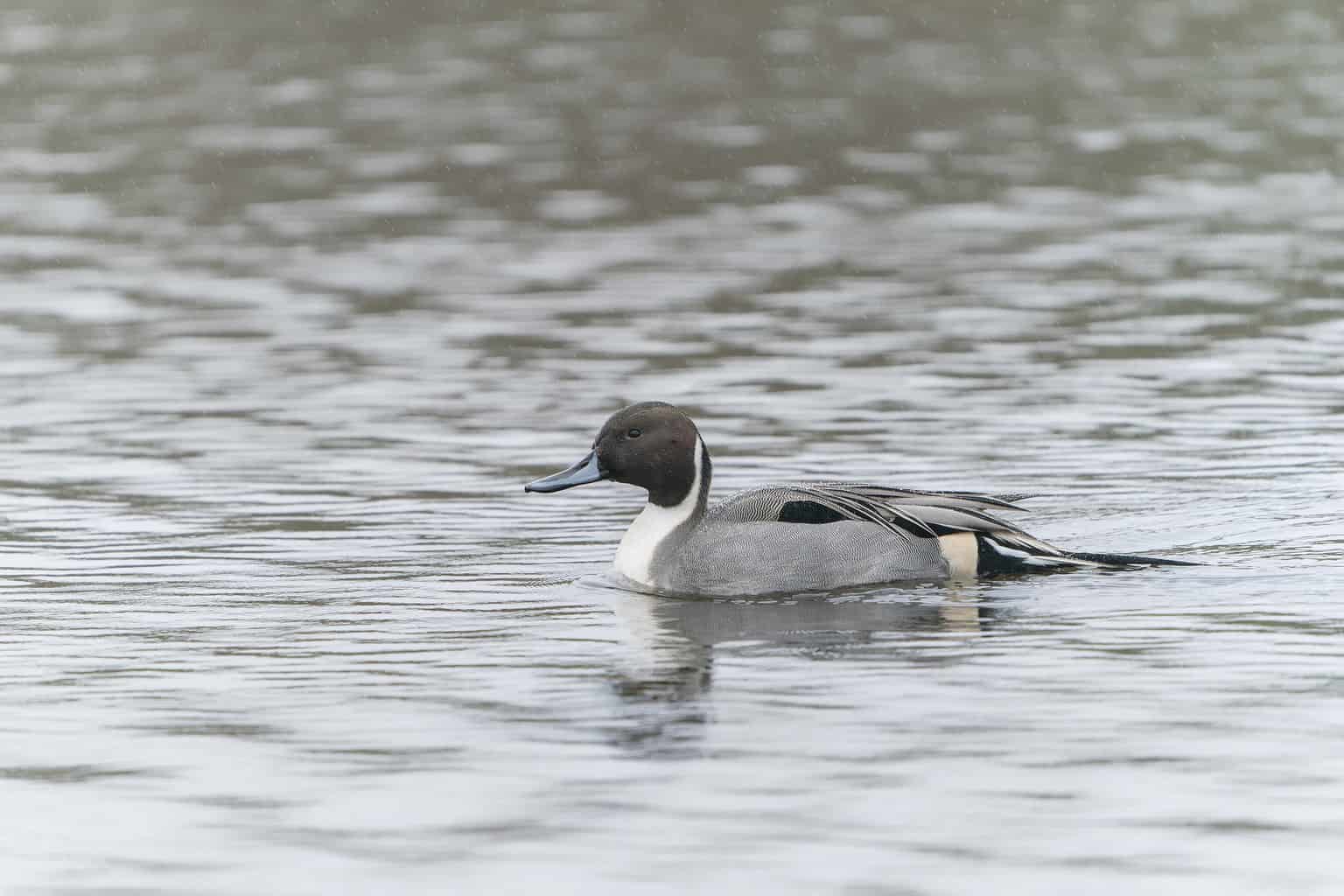
- Anas acuta
- Length: 20 – 26 in (51 – 66 cm)
- Weight: 36.33 oz (1030 g)
- Wingspan: 29 – 35 in (74 – 89 cm)
The Northern Pintail is yet another winter resident of Texas. Because of this, you are unlikely to see them with their signature “pintail,” which is a group of long, pointed tail feathers that the males sport in summer.
In winter, the male still has a pointed tail. He has a brown head and a white stripe down his neck. His body is gray, white, and black. He also has a green speculum.
Female Northern Pintails have short, pointed tails and an intricate, scaled pattern in light and dark brown.
Because they fly up to 48 miles per hour, their speed makes them a popular challenge for duck hunters.
Northern Shoveler (Dabbling Duck)
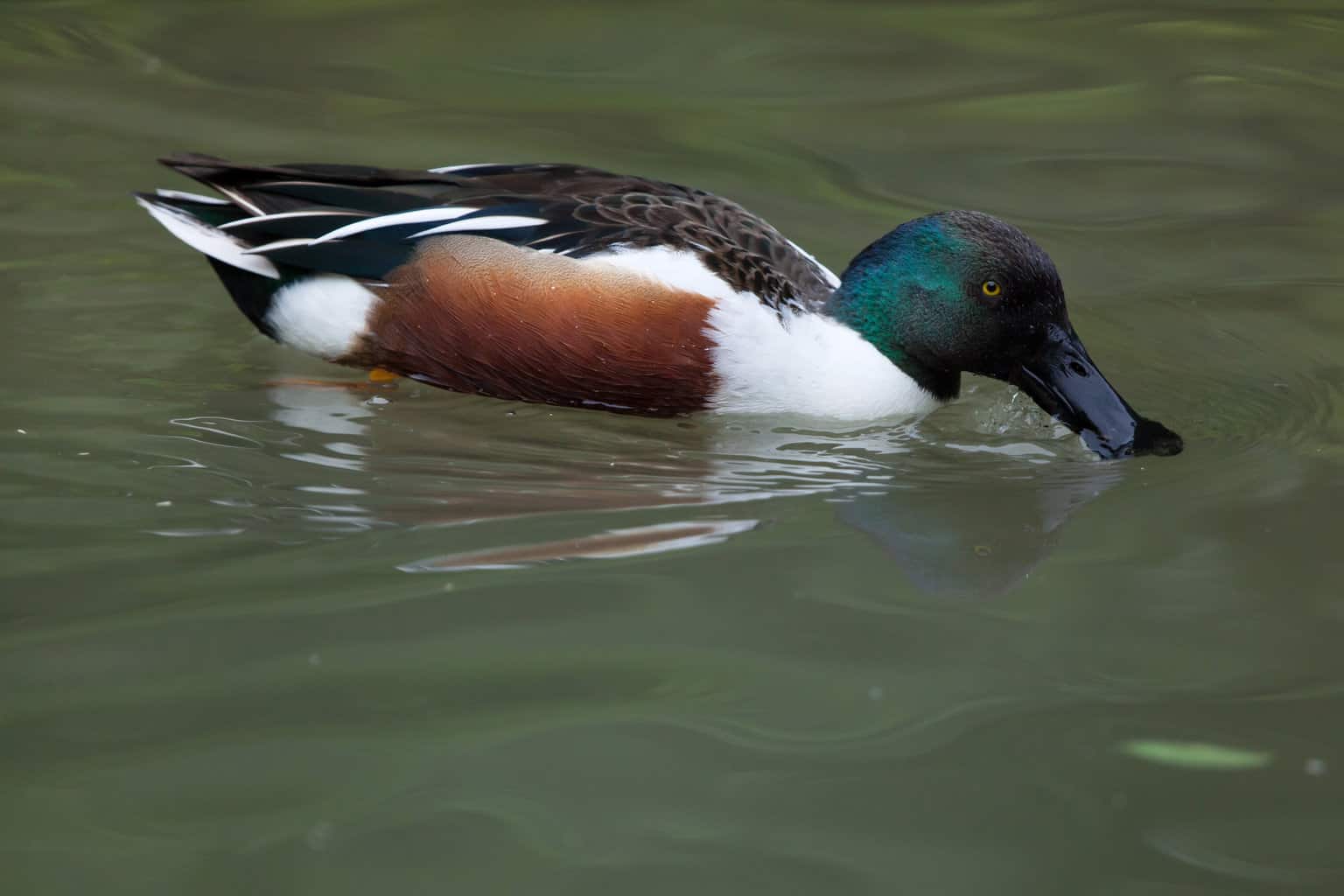
- Spatula clypeata
- Length: 17.3 – 20.1 in (44 – 51 cm)
- Weight: 14.1 – 28.9 oz (400 – 820 g)
- Wingspan: 27.2 – 33.1 in (69 – 84 cm)
Like the Mallard, the Northern Shoveler has a gorgeous, iridescent green head. However, that is where the similarities end.
The bill of the Northern Shoveler is spatula-shaped. The male’s is black, whereas the female’s is orangey-brown. The Northern Shoveler uses its bill to scoop up mouthfuls of water. Then, they let the water slip out of their bill while sifting out plants and aquatic prey.
They are mostly winter residents of Texas, but some individuals may stick around all year. Those that are here for the breeding season will build a nest in the reeds and grasses near their preferred water source.
Northern Shoveler nests are often a little gross to humans because they defecate on their eggs to make them unappealing to predators.
Red-Breasted Merganser (Diving Duck)
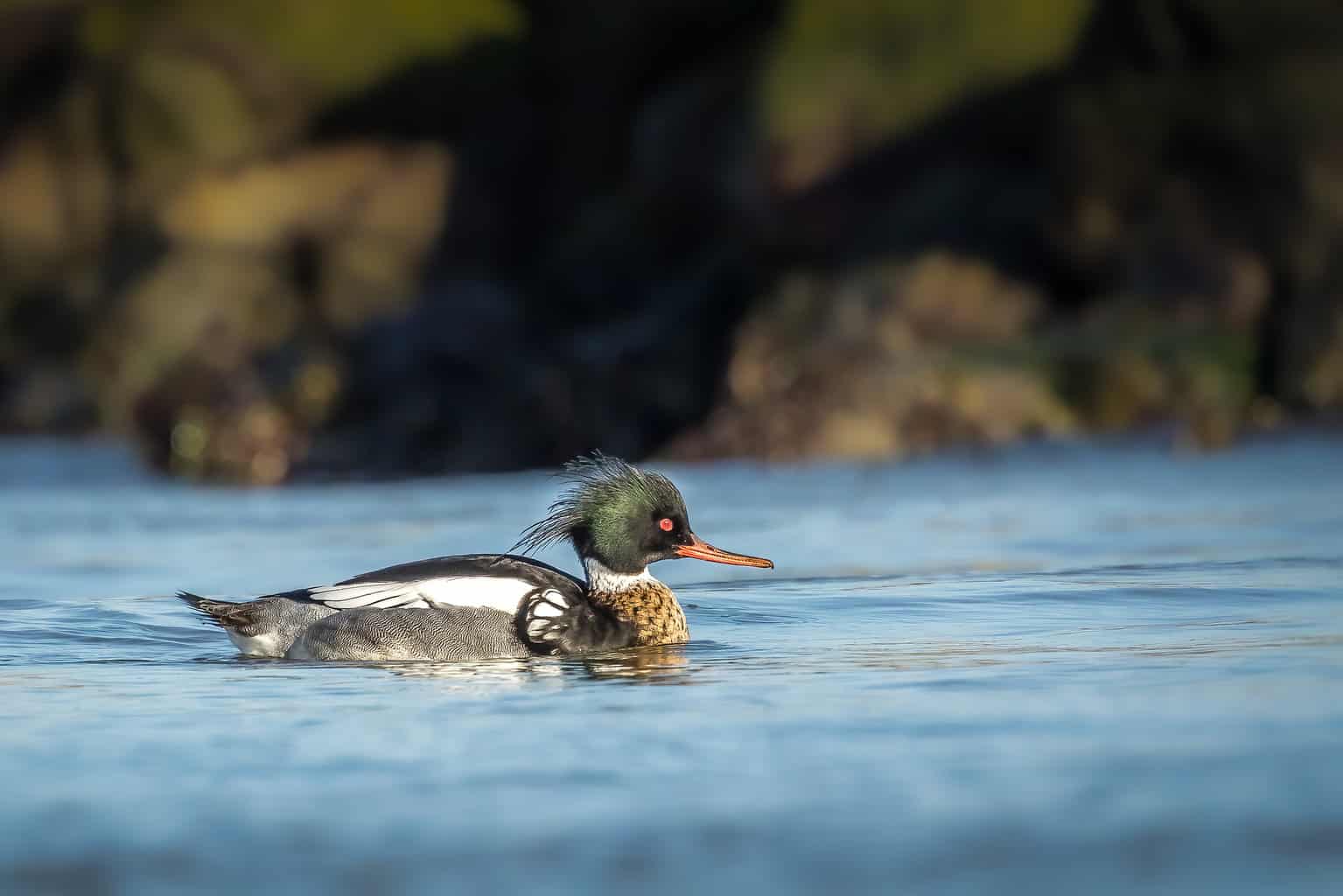
- Mergus serrator
- Length: 16 – 26 in (41 – 66 cm)
- Weight: 47.61 oz (1349 g)
- Wingspan: 31 – 35 in (79 – 89 cm)
Like other Merganser species, the Red-Breasted Merganser has a shaggy crest.
Males have an iridescent green head with a very thick white neck ring. He has an orange sawbill and won’t reach sexual maturity until he is 2 years old.
Females have a cinnamon-brown crest and head with a gray body and white throat. Her thin, orange bill looks just like the male’s, and she has red eyes.
They migrate throughout Texas in the spring and fall. The only place in Texas where they spend the winter is along the Gulf Coast.
They are one of the fastest diving ducks on record, flying up to 81 miles per hour! That’s the speed limit on most Texas interstates!
Redhead (Diving Duck)
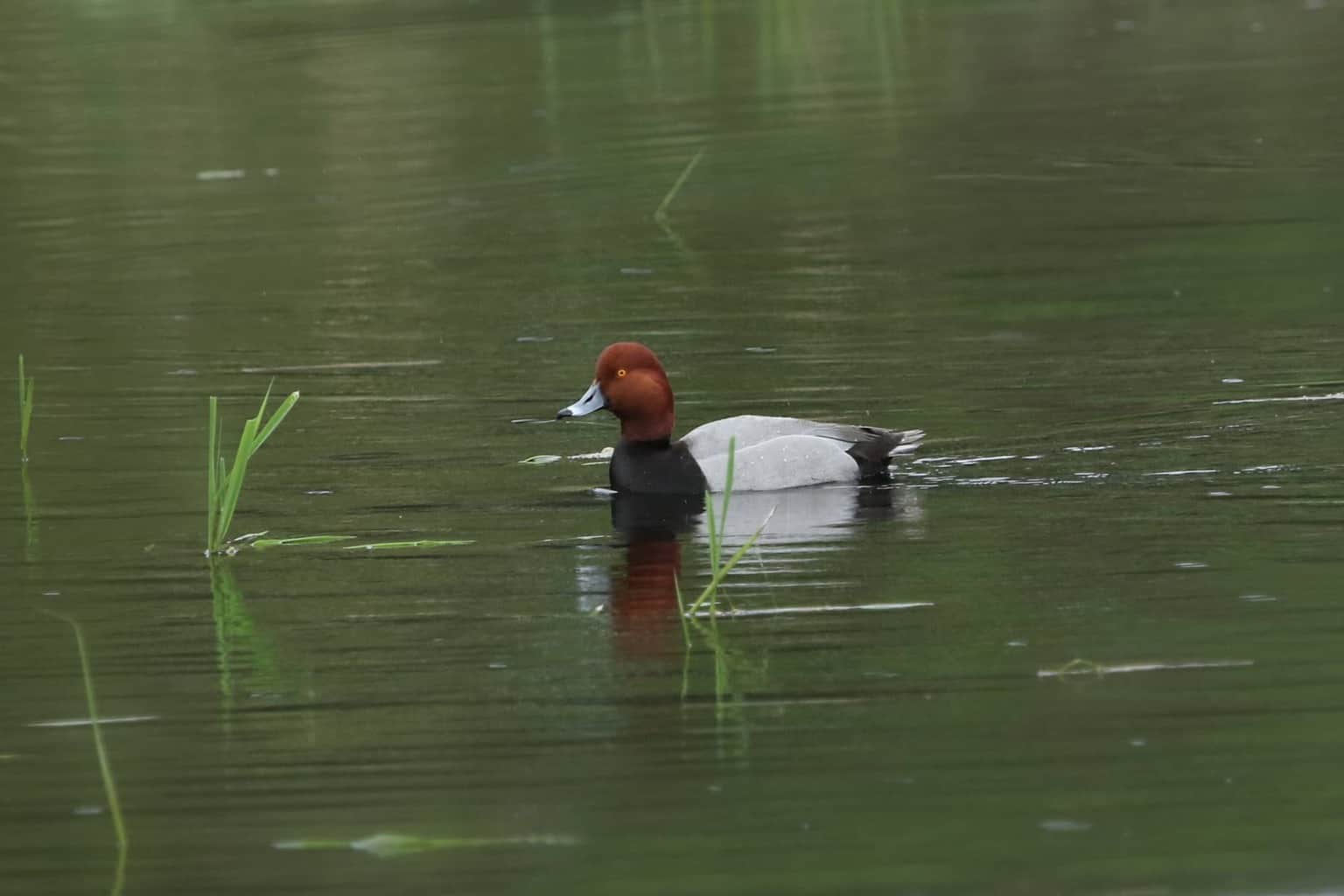
- Aythya americana
- Length: 18 -22 in (46 – 56 cm)
- Weight: 43.03 oz (1219 g)
- Wingspan: 29 – 35 in (74 – 89 cm)
Male Redheads don’t exactly have a “red” head, but it is dark and coppery-brown. He has a dark gray bill that is tipped in black. The rest of his body is gray and black.
Female Redheads have minimal markings. They have brown bodies and black-tipped bills, just like their male counterparts.
Redheads are found in Texas during the winter or during the migration season. They arrive in Texas in September and October, especially along the central and southern coasts. They are especially common in the Laguna Madre area. In the rest of the state, they stick around for all of winter.
As brood parasites, Redheads lay their eggs in the nests of other ducks, including other Redheads. However, they are not exclusively parasitic. The Brown-Headed Cowbird, for example, doesn’t even need to build her own nest because she lays all of her eggs in other birds’ nests.
Redheads build their own nests and raise their own young – they just also lay eggs in other nests in hopes of improving their rates of reproductive success.
Ring-Necked Duck (Diving Duck)
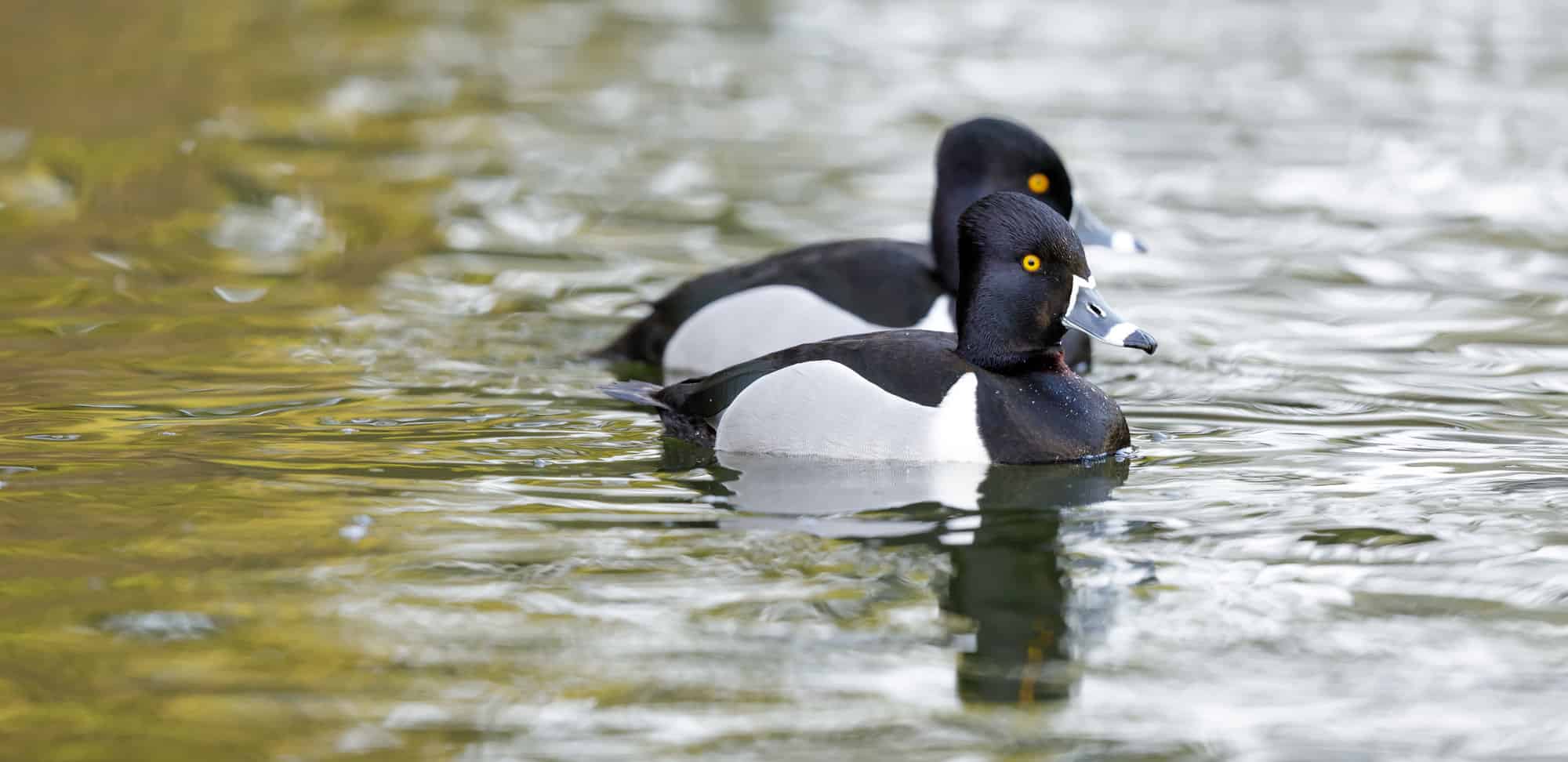
- Aythya collaris
- Length: 14 – 18 in (36 – 46 cm)
- Weight: 32.09 oz (909 g)
- Wingspan: 24 – 30 in (61 – 76 cm
The neck ring on a Ring-Necked Duck is hardly detectable from any distance at all. Perhaps it stood out to the 1800s naturalists who were examining deceased specimens in order to give them their names, but today, the Ring-Necked Duck seems like it has the wrong name.
Male Ring-Necked Ducks have a white belly and a lot of black on their body: chest, back, and head. He has a white band around the edge of his black bill, and a white ring that runs along the base of his bill, on his face.
Females are brown. They have gray faces and white outlines around their eyes. The female does not have a ring on her face, around the base of her bill, but she does have a white band near the tip of her bill.
They are winter residents in most of Texas, although they migrate through the very northern edge of the Texas Panhandle instead of sticking around.
Ruddy Duck (Diving Duck)
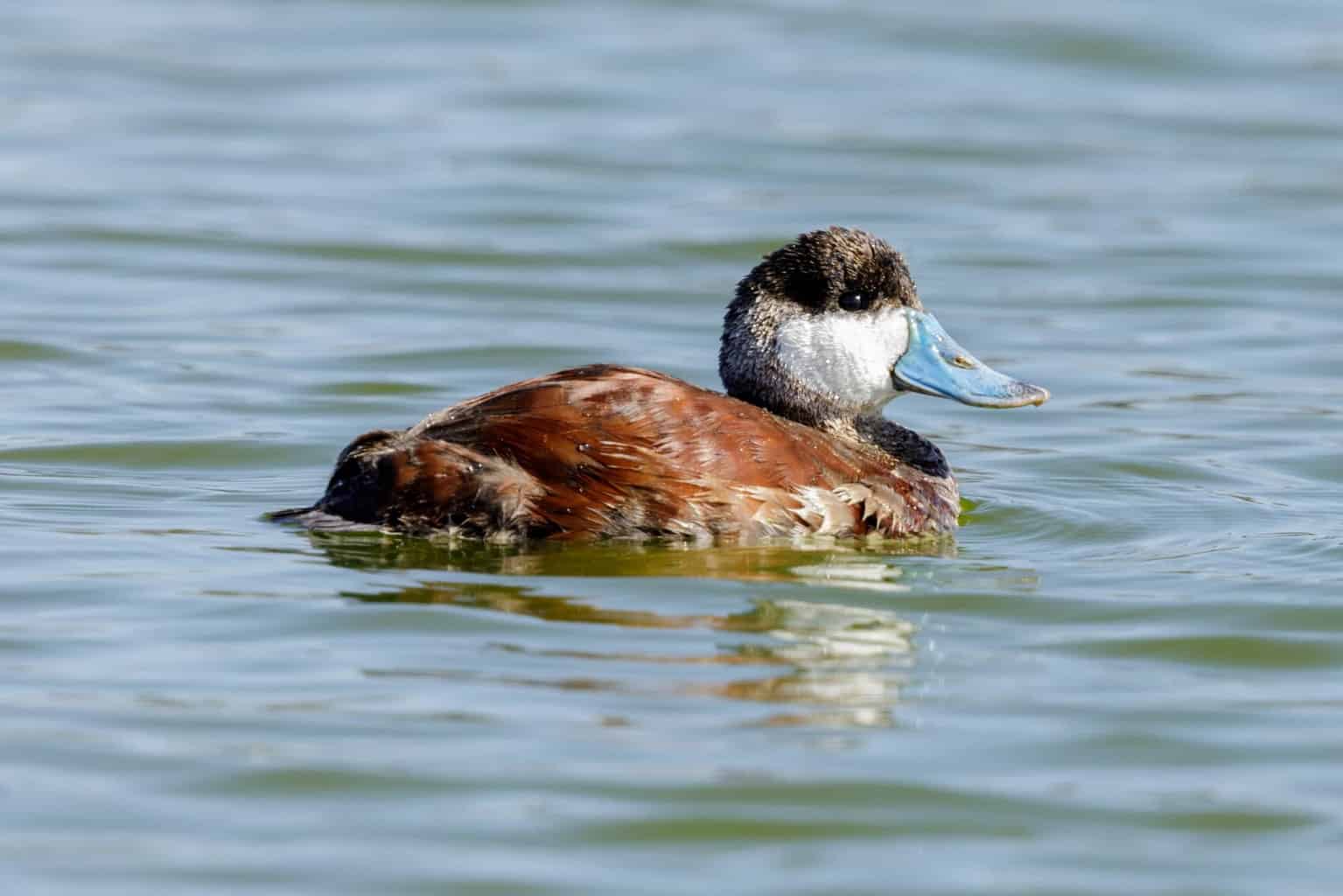
- Oxyura jamaicensis
- Length: 14 – 16 in (35.56 – 40.64 cm)
- Weight: 28.04 oz (795 g)
- Wingspan: 21 – 24 in (53 – 61 cm)
Ruddy Ducks look pretty different between summer and winter.
The breeding season lasts from May to August, and males in this season are dark brown. After they breed and migrate, they molt and turn to a dull gray color. They have a black cap and a large white cheek patch, as well as a sky-blue bill.
Females are dappled in different shades of brown. Her cheek patch is gray, and her bill is black.
Ruddy Ducks live in different areas of Texas, depending on the season. They are migratory visitors in the Texas Panhandle and North Central Plains. In the rest of the state, they settle in for the winter.
Ruddy Ducks are native to North America. They are also found in Europe because they were brought to England in the 30s and 40s as captive species. They were able to escape and thrive from the 1950s to the 2000s.
As a non-native species in Europe, there have been concerns about the impact of Ruddy Ducks on the similar-looking White-Headed Duck. Ruddy Ducks have been so successful at interbreeding with White-Headed Ducks that the native European species is now threatened.
Surf Scoter (Diving Duck)
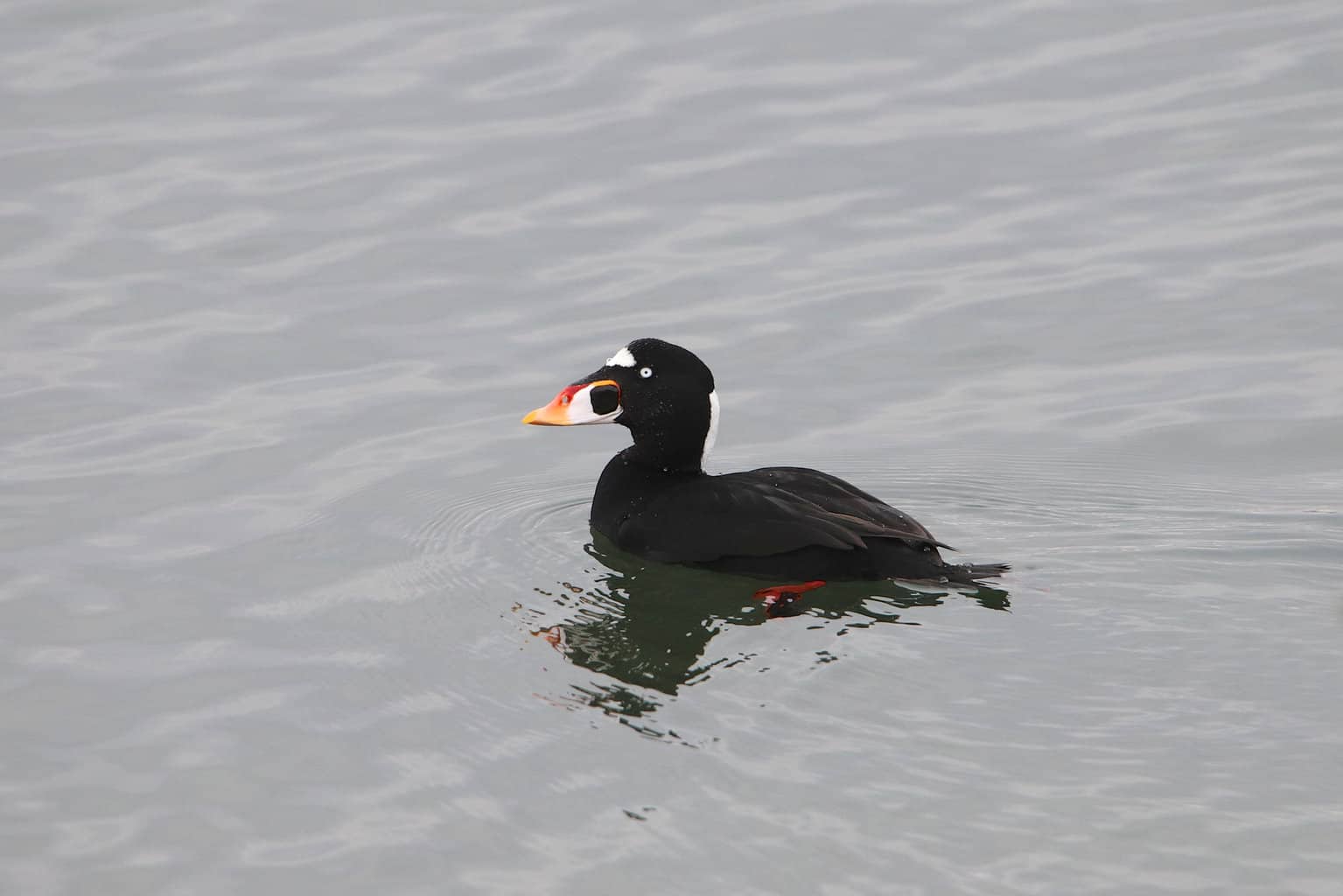
- Melanitta perspicillata
- Length: 17 – 21 in (43 – 53 cm)
- Weight: 35.27 oz (1000 g)
- Wingspan: 30 – 36 in (76 – 91 cm)
Surf Scoters are spottable because of their big, thick bills. The male Surf Scoter has a large, sloping forehead and a dramatically large bill that is orange, red, and yellow. The rest of his body is black, with white spots above his bill and on the base of his neck.
Females have a smaller, dark gray bill. Females are dark gray, and they have a white patch on the back of the neck. They have white patches behind their eyes, too.
Surf Scoters breed in northern Canada and Alaska. They spend the winter season on all of the North American oceanic coasts, including the Gulf Coast of Texas.
They live on the coast, in both bays and estuaries.
White-Winged Scoter (Diving Duck)
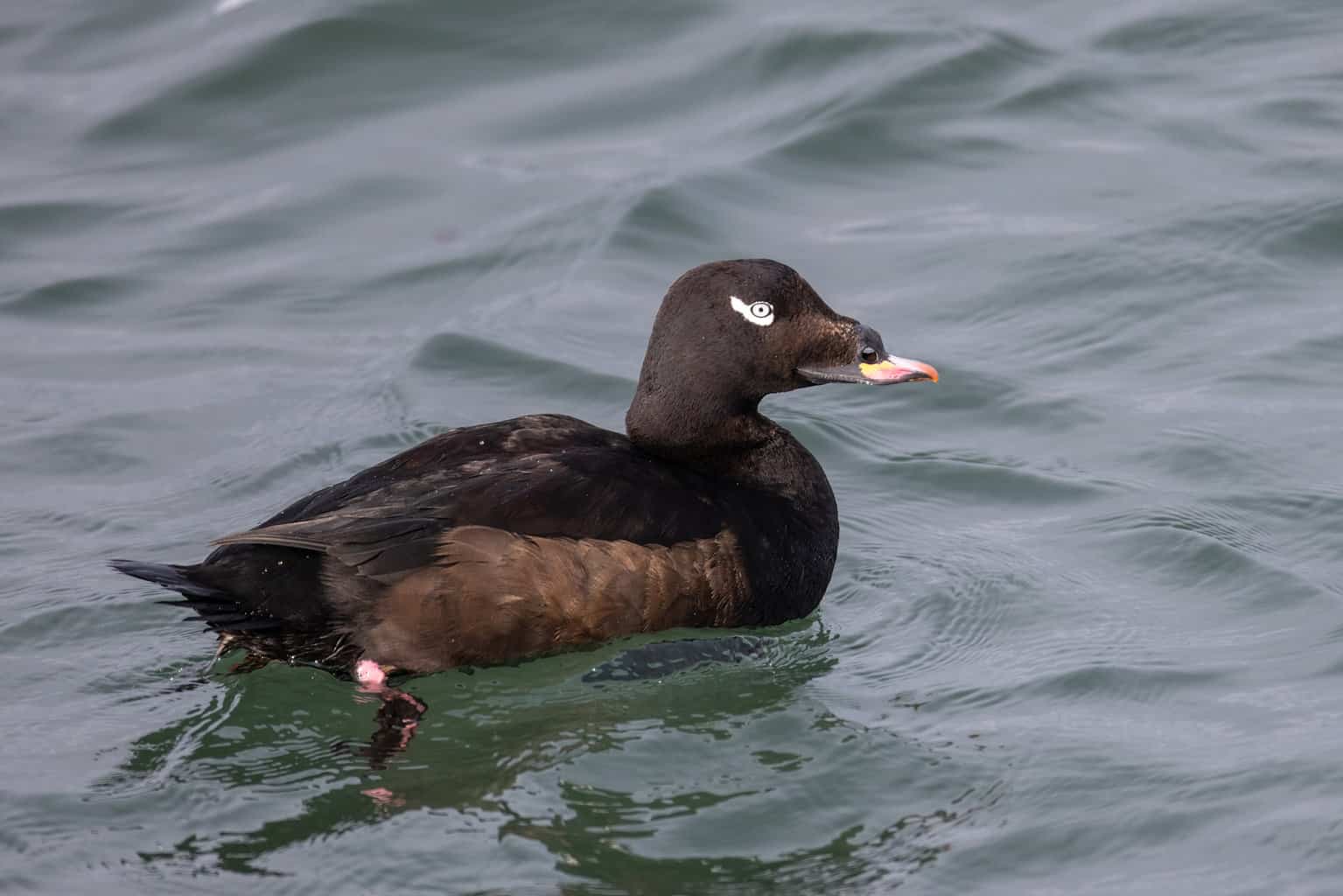
- Melanitta deglandi
- Length: 19 – 24 in (48 – 61 cm)
- Weight: 62.4 oz (1768 g)
- Wingspan: 33 – 41 in (84 – 104 cm)
White-Winged Scoters have a bulky bill, which is somewhat similar to the Surf Scoter. The White-Winged Scoter’s bill is thick near the base and thinner at the tip.
Both males and females look mostly the same. The biggest difference is that the male has a “reverse comma” pattern over his eyes, and he has a long white stripe down his wings.
Females are very dark brown and may look almost black. She has a small white cheek patch.
Like other Scoters, White-Winged Scoters breed in the far northern reaches of Canada, but winter along the oceanic coasts of North America. You may see them all the way from Galveston to South Padre Island.
Wood Duck (Dabbling Duck)
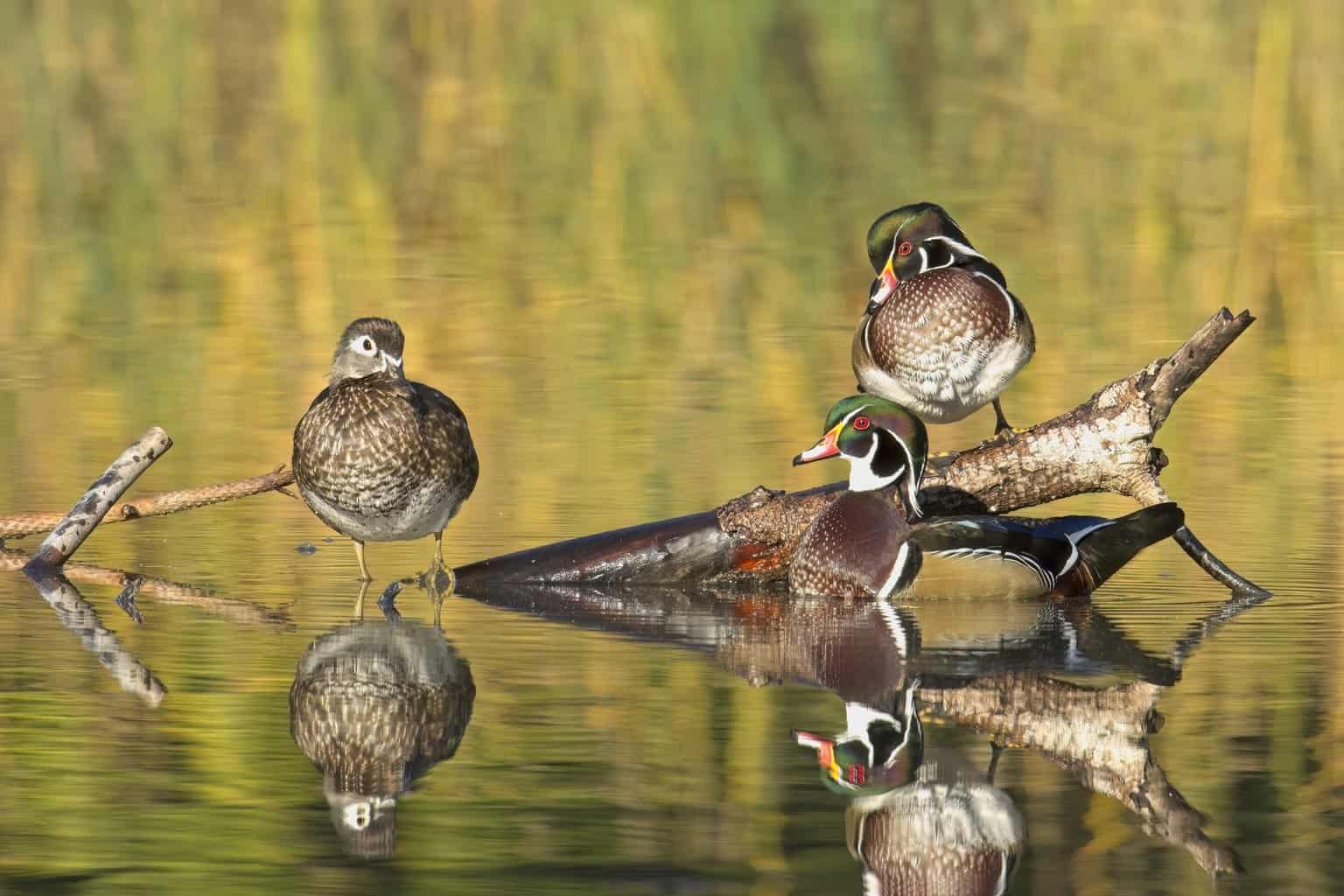
- Aix sponsa
- Length: 18.5 – 21.3 in (47 – 54 cm)
- Weight: 16.0 – 30.4 oz (454 – 862 g)
- Wingspan: 26.0 – 28.7 in (66 – 73 cm)
Wood Ducks are flashy little ducks!
The male has an iridescent green head with a long crest at the base of his head. He has buff-colored sides and a chestnut-brown breast that is dappled in cream-colored spots.
All over his body, he has white stripes and markings. His bill is complicated in color, with portions that are red, orange, black, and white.
The female has a gray head and brown body, a blue speculum, and a small crest atop her head. She has a white rim around her eyes.
They are year-round residents of Texas who nest in abandoned tree cavities up to 60 feet in the air. They chose trees that are very close to the water, preferring to live near rivers, ponds, and swamps.
Wood Ducks are more common in East Texas, although they also live in West Texas.
The Final Word on Ducks in Texas
As you can see from this list, there are so many fascinating ducks in Texas!
In addition to the ducks listed here, there are still a few more that accidentally end up here on their long migrations between winter and summer territories. Still, these are the ducks you are most likely to see in Texas.
Some are only here for the winter, and some are year-round residents, but all of them find their way to Texas’s lakes, ponds, ocean bays, estuaries, swamps, and more.
These ducks join the long list of gorgeous and interesting birds in Texas.
Whether you are visiting Texas or you live here, there are so many great ducks to add to your Life List. To make things a little easier, check out some of the information we’ve put together about essential birding gear, including spotting scopes and binoculars.
Once you start paying attention, you are going to start seeing interesting ducks all over!

